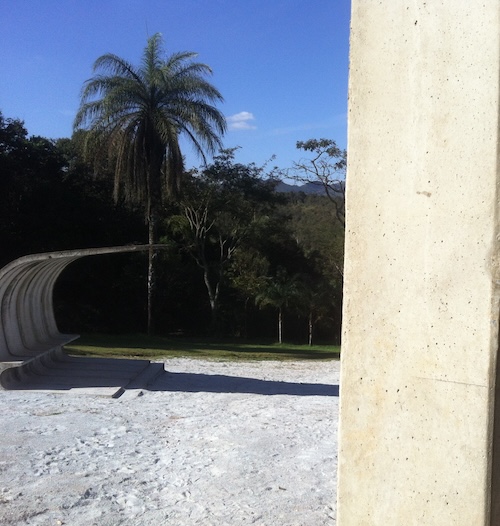Woven, Inscribed, Enfolded, Encased
Woven, Inscribed, Enfolded, Encased: Adinkra from Kumase to the British Museum
By Adrian Anagnost
Abstract
This article traces the nineteenth-century circulation
of Asante material culture from Kumase to the British
Museum, exploring how the intersecting imperial
strategies of the Asante and British empires are
manifested in collecting practices. Rather than tracing
object biographies from Africa
to Europe, this text foregrounds Asante
imperial collecting, which appropriated diverse visual
and material forms from Akan, Dagomba, Hausa, and
Islamic communities as a means of asserting imperial
power and cosmopolitan identity. As diplomatic exchanges
gave way to looting, the Anglo-Asante Wars, and colonial
possession over the nineteenth century, European museums
redefined Asante material culture. This article analyzes
how early nineteenth-century European museum displays
and publications, especially writings by the aspiring
English diplomat Thomas Edward Bowdich, constructed a
reductive narrative of “African art”. Additionally, by
centering Asante cosmopolitanism, the article
underscores the dynamic and adaptive strategies that
defined Asante imperial visuality.
This article is part of the series “Atlantic Worlds:
Visual Cultures of Colonialism, Slavery, and Racism” in
British Art Studies, which is funded by the
Terra Foundation for American Art. Projects in the
series consider the dispersed and difficult histories of
Atlantic worlds, focusing on any aspect of visual and
material culture that intersects broadly with the United
Kingdom and the United States. The aim is to encourage
transhistorical thinking by posing questions about
histories and legacies of empire, networks of trade,
transatlantic slavery, and creolisation. “Atlantic
Worlds” initiated a virtual residency programme at the
journal that ran from 2021 to 2022, where awardees
shared ideas with each other and were supported by
expert interlocutors. Awardees were Adrian Anagnost,
Anna Arabindan-Kesson, Mia L. Bagneris, Ananda
Cohen-Aponte, Christopher Maxwell, and Adrienne Rooney.
Invited interlocutors were Gaiutra Bahadur, Pamela
Fletcher, Aaron Kamugisha, Catherine Molineux, José
Lingna Nafafé, and Kerry Sinanan.
From Imperial Appropriations to “African Art”: Asante and British Collecting Practices
In 1831 a group of objects acquired in the Asante Empire and Gabon entered the British Museum collections (fig. 1).1 These items—perhaps the first art from sub-Saharan Africa to enter the British Museum—include clay pipes, colorful glass beads, an iron lock and key, an iron and brass blade and a brass-wrapped wooden sheath, a leather cushion with kapok fiber stuffing, a tasseled leather bag, a stringed instrument, sandals, a carved wooden stool, plain woven cotton, and stamped adinkra cloth. Although the British Museum formally added them to their collection only in 1831, these objects had been at the institution since 1818, when the Englishman Thomas Bowdich presented them to the museum.2 Bowdich had acquired these items while on an 1816–18 “mission” sponsored by the British-chartered Company of Merchants trading to Africa—the African Company—centered on an 1817 journey to the Asante capital of Kumase (Coomassie).3
1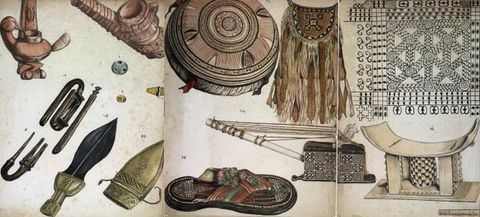
Located near the Gulf of Guinea in West Africa, the Asante Empire was formed out of conquests and consolidation in the late seventeenth century. It was a multiethnic polity dominated by Twi-speaking Akan people—the Asante—with inhabitants from Hausa, Dagomba, other Akan, and additional ethnic groups.4 Asante’s capital, Kumase, was located in a forested region of the interior, at a geographical nexus of inland trade routes reaching northward toward the Sahel and east–west along the forest–savanna interface. Kumase was some distance inland from the Gold Coast. There, West African ethnic groups such as the Fante and Ga competed to dominate overseas trade in captive Africans, gold, ivory, and other goods.5 In the eighteenth century, Asante expansion from the forest toward the coast ousted many intermediaries, with the result that Asante representatives increasingly dealt directly with European coastal traders and Euro-African trade agents at ports such as Elmina, Cape Coast, and Accra.6 Furthermore, in the early nineteenth century, the de jure ending of the transatlantic trafficking of enslaved people by the Danish (1803), British (1807), and Dutch (1814) governments spurred efforts to transition to “legitimate commerce” across this region.7 In the wake of abolition, African and European entities sought new models for commercial relationships, reaching from Kumase in the interior and its Sahelian trade partners, through entrepôts along the Gold Coast, and overseas to Europe. It was in this context of shifting trade and diplomacy that Thomas Bowdich visited Kumase in 1817.
4From the Asante point of view, selling or gifting objects from the cosmopolitan city of Kumase to European visitors could smooth diplomatic relations and lay the groundwork for future commercial transactions—building on long-standing regional practices of trade, diplomatic gifting, and pageantry.8 Moreover, the Asantehene (Asante ruler), Osei Tutu Kwame Asibey Bonsu, appeared to be motivated by the goal of placing objects on display in a European museum as a way to communicate Asante imperial power abroad, which paralleled his own local practices of collecting and display.9 When Bowdich informed the Asantehene of the British Museum, the ruler presented him with six items of goldwork for the museum; Bowdich noted that “I had interested the King [Asantehene], by my account of this national repository”.10 The Asantehene’s early nineteenth-century donation of goldwork contrasts sharply with late nineteenth- and early twentieth-century British Museum acquisitions from the region, which were largely rooted in the punitive logic of the Anglo-Asante Wars.11 Where Bowdich presented these items to the British Museum to establish his own capabilities as a colonial agent and scientific explorer, the Asantehene sought enhanced trade and the promotion of Asante imperial power internationally.12
8This article traces the intersecting aims of dual imperialisms, with the Asante Empire’s practices of imperial collecting eclipsed by those of the British Empire, as the items collected in Asante entered the British Museum. The relocation of objects from the Asante Empire to the British Museum was both a political and economic maneuver by Asante elites and the Asantehene, and an ideological framing of museum collections through the lens of Britain’s emerging global empire. In the early and mid-nineteenth-century British Museum, the objects acquired in Kumase were labeled: “All from Ashantee. Presented by T. E. Bowdich, Esq. and described in his Travels”.13 While it is true that Bowdich obtained (most of) the items during his time in the Asante Empire, the phrase “all from Ashantee” conceals a great deal of complexity (figs. 2 and 3). For one, Asante Empire material culture and collections incorporated objects from across Europe as well as from West and North Africa, but Bowdich’s collecting process did not include European items.14 Additionally, the Asante Empire was culturally diverse. While recognizing the challenges of defining ethnic categories, we can understand the Asante as the coming together of several subsets of the Akan ethnic group who organized into a federation just before 1700.15 The Asante imperial consolidation across the forest zone went on to encompass diverse Akan and non-Akan groups, and Asante imperial arts overtly appropriated varied arts and material culture into a cosmopolitan visuality.16
13
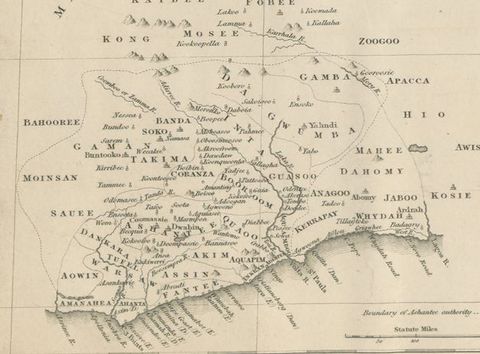
By incorporating items from across a broad geographical range, the Asante Empire exemplified how “nineteenth-century imperial power structures provided a fertile breeding ground for cosmopolitanism”.17 As Malcolm McLeod, former keeper of the Department of Ethnography at the British Museum, and the art historian Fiona Savage have shown, Asante gifting and collecting practices reveal how royal authority depended on appropriating exogenous visual and material culture.18 While Asante strategies emphasized cosmopolitan appropriation, the early nineteenth-century British Museum display crafted a different geography for these objects. The British Museum obscured the multiethnic character of objects by Akan, Hausa, Dagomba, and other artisans behind the internationally known political entity of the Asante—and under Bowdich’s name. Extending the museum’s generalizing of categories, Bowdich further reframed these works in a second book that proposed a pan-African art history.
17Adinkra exemplifies these simultaneous Asante and British imperial strategies. Adinkra cloth is a stamped textile that is regarded as a quintessentially Asante cultural form, yet its formal and material roots are in diverse communities throughout the Asante Empire. Adinkra cloth was originally made from cotton woven in long strips on small foot looms, and sewn together into large swathes decorated with repeated patterns arranged in a grid (fig. 4).19 The repeated patterns on the cloth, each of which was associated with an Akan proverb or saying, were traditionally stamped using small calabash gourds carved in relief, using an ink made from boiled badie tree bark and, sometimes, slag trailings left over from iron smelting or smithing.20
19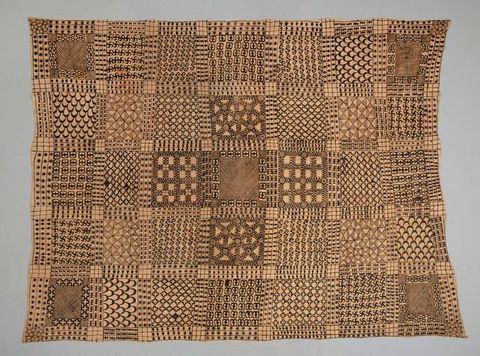
As the art historian Allison Martino has noted, adinkra cloth was used as a mourning garment by elites, and then popularized across the social ranks in other contexts throughout the Asante Empire and in Akan areas of the British Gold Coast colony during the late nineteenth and early twentieth centuries.21 Initially handwoven and hand-printed by male artisans, adinkra textiles were later produced as machine-printed cloth by British companies (figs. 5 and 6).22 While oral accounts of adinkra’s origins center on textiles, the term adinkra is more broadly understood to mean the printed motifs on the cloth: adinkra symbols linked to Akan proverbs and other Akan oral expressions including songs, riddles, and prayer.23
21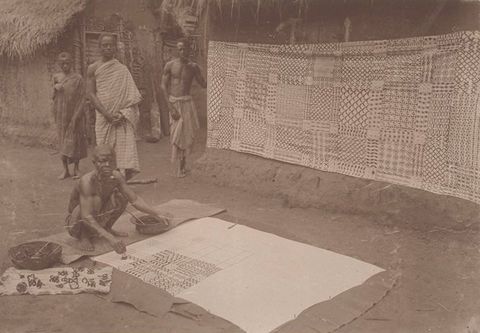

Developed in dialogue with Islamic talismanic calligraphy and metalwork, reliant on Dagomba textile expertise, and steeped in Akan orality, adinkra is quintessentially Asante because of its cosmopolitan composition.24 However, emergent modern museological frameworks flattened the difference. At the early nineteenth-century British Museum, Asante works, like many other artworks from outside Europe, were understood according to an ideal of homogeneous polities. Adinkra was one of several items that stood in for the Asante Empire, alongside object sets from other sites where British “expeditions” were paving the way for imperial intervention. Once placed in the museum and abstracted from its diverse origins, adinkra could be reframed according to the logics of art historical study. Through formal analysis and reduction of the adinkra to constituent patterns, Bowdich’s second book reinterpreted adinkra through a comparative examination of what he called “arts common to the ancient Egyptians, Abyssinians, and Ashantees”—an early diffusionist proposal for the field of African art.
24Adinkra fabric and other objects from Africa were decontextualized and reauthored in British Museum displays, then fragmented in the space of the printed page. Each stage of adinkra’s shifting geography offered a new comparative framework, from the Asante Empire and its borderlands to the cosmopolitan space of Asante’s capital, Kumase, to the imperial framing of the British Museum. The historian Makhroufi Ousmane Traoré has described similar modes of spatial reconfiguration as disenclavement, “that is, an act of ending the isolation of a given geographic zone—beyond the already familiar regions”.25 Traoré’s focus is the opening up of an “ethnic state [in Africa] to a global economy (the Atlantic system)”, and how connections to the Atlantic Coast trade and beyond reshaped patterns of circulation around trans-Sahelian routes.26 In the case of adinkra, this opening up to different circuits saw adinkra patterns move across the complex visual and material matrices of multiethnic trade centers, cosmopolitan Kumase, and the British Museum.
25I take these Asante objects, especially adinkra, as a case study for understanding how art from Africa entered European collections under conditions of imperialism. I ask two intersecting questions. First, how can we connect African objects in European museum collections to their origin sites, understood not as static and unchanging but as dynamic and heterogeneous? This article thus takes up the model posed by Claire Bosc-Tiessé and Peter Mark to “articulate the process whereby the objects were removed from the society of their creation and, ultimately, redefined as ‘African art’”.27 This requires an analysis of two different imperial projects—the Asante and the British—and an examination of distinct strategies for confronting and absorbing exogenous cultural forms. While Malcolm McLeod points out that “it has become a cliché … that much of Asante material culture had its origin outside Asante,” and he cautions that, “This view overlooks completely the fact that cultures have a preexisting system of classification and evaluation, a pervasive cosmology which influences the utility and attractiveness of the new items”.28 The first half of this article thus traces Asante approaches to incorporating “foreign” cultural forms into imperial imaginaries, arguing that Asante imperial power was predicated on its ability to appropriate and mobilize diverse metaphysical and technical powers into an Asante imperial imaginary. Adinkra cloth and adinkra symbols were enmeshed in ensembles of visual, oral, and material culture that presented cosmopolitanism as a feature of the Asante Empire.
27Second, how can we understand the processes by which institutions such as the British Museum and Western art history have constructed their objects of study? Adinkra textiles entered museum collections in the Global North when European museums were concluding their shift from a cabinet of curiosities model to the model of a modern disciplinary institution. At the British Museum early displays promoted an “expeditionary” narrative of explorers gathering fascinating objects from potential imperial conquests. However, the museum’s display practices and Bowdich’s publication would soon subsume these objects—including adinkra—under emerging definitions of “African art” and ethnography. The second half of this article analyzes how the British Museum and Bowdich’s books reinterpreted adinkra and other objects from the Asante. Following Bosc-Tiessé and Mark, studies of African objects in museums should bring together an understanding of how museums have conditioned interpretations and, at the same time, reject the notion of a pure and authentic origin.
This is not merely a question of ameliorating the decontextualization enacted by the museum, of deploying object biography to reverse an object’s journeys and return it to an “original” meaning. As Dan Hicks has written in an earlier issue of British Art Studies, “the notion of object biography has served to fix the boundaries of things rather too firmly by tending to overestimate physical constancy in the face of movement between shifting human contexts”.29 At the same time, I contend that forensic practices for recapitulating the violences and losses of looting, advocacy for the return of discrete objects, and contemporary interventions in museums are insufficient. These approaches often limit historical accounts to European imperial points of view that reaffirm the problematic neglect of premodern African histories and art histories. However, this period also reveals intersecting imperialisms, including non-European imperialisms. Rather than defining Asante material culture as a coherent and timeless entity, we should instead recognize how imperial strategies within West Africa incorporated and transformed exogenous artistic traditions into distinctly Asante forms at a particular moment in Asante history. By understanding these dynamics, art historians can better account for empires where European powers were not the protagonists, and appreciate African agency as a force that shaped expansive material and artistic worlds—beyond the reactionary frameworks that are tied to European hegemony.30 Where museums of the Global North have tended to emphasize exemplary, singular works of art authored by a single figure or ethnic group, these works demand to be understood in the context of arrays of visuality, material culture, and spatial orders from dynamic societies.
29Woven: Asante Consolidation
Throughout Asante campaigns of conquest and consolidation in the seventeenth and eighteenth centuries, Asante material culture and oral histories show an openness to “foreign” artisanship, an incipient cosmopolitanism at the root of Asante imperial rule.31 This is perhaps unsurprising, given that the Asante came together at a nexus of multiple key crossroads of regional and global trade. Prior to the Asante Empire, emergent Akan polities were poised at the heart of a gold- and kola nut-producing forest region inland from the Gold Coast, at a hub of trade routes from the Sahel–savanna interface to the forest in the south; from Assinie in present-day Ivory Coast in the west, through areas of Allada/Ardra (later Dahomey) into Benin in the east; and bridging the forest–coast divide (fig. 7).32 As the entry of European weapons into the area disrupted the regional political balance, Akan groups seeking to establish control over trade pushed both south- and northward.33
31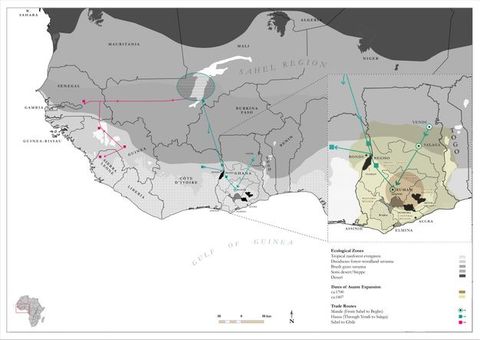
Even before the Asante came together as a federation or empire in the mid-seventeenth century, some sources distinguished between Akan groups that were known for their martial and mercantile expertise and other Akan groups that were skilled in artisanship such as textile manufacture. An early seventeenth-century Dutch map, for example, enumerates dozens of West African polities, including “great acanij … rich in slaves”, the principal gold merchants of “acanij”, an undistinguished “akan” group, the “bonnoe” who are “simple” and have no forest, and a locale with no gold called “insoco” (fig. 8). The map label for Insoco describes how its “cloths woven like carpets” were highly esteemed by the “acanisten”—potentially encompassing all the various Akan groups to the south, including the pre-Asante Akan polities of Acanij and Great Acanij.34 These distinctions in expertise—military, mercantile, and artisanal—were linked to particular trade and production centers. One such center was the inland market of Insoco, or Bɛo-Nsokɔ (historical Begho), active from around the fourteenth century through its abandonment in the late eighteenth century.35
34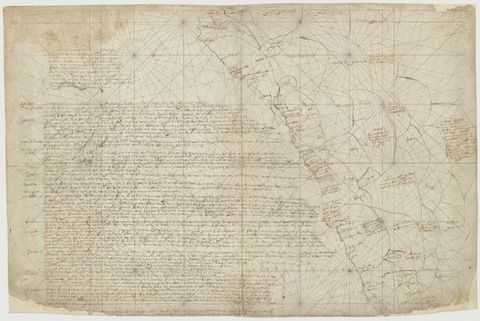
As a key junction between Saharan caravan trade routes and Akan forest regions to the south, Bɛo-Nsokɔ’s inhabitants included the Bono (Brong) Akan people, Mande-speaking Dyula traders (some of whom were Muslim), and diverse communities of craftspeople.36 Linguistic evidence and archaeological evidence, such as seventeenth-century spindle whorls and dye tools, substantiate an inland center of cotton textile production at Bɛo-Nsokɔ, situated in the savanna–forest ecotone at the north-northwest boundaries of the region that would become Asante.37 Additionally, around 1700, a French apostolic prefect visiting Assinie, farther west along the coast, noted that traders from inland brought “Turkish carpets”, along with “fine cotton fabrics striped with red and blue silk” from “Enzoko” (Bɛo-Nsokɔ).38 Thus, from this early period, textile expertise is located northwest of the Asante heartland.
36While the Asante would develop indigenous modes of textile production at the heart of empire no later than the eighteenth century—most famously, kente cloth—evidence points to a consistent practice of importing important textiles and textile techniques from the edges of empire.39 Since cotton grows in the savanna region but not the forest, it is understandable that textile technologies would come to the Asante from the north.40 Narrow band, or strip, weaving on small looms may have been introduced into Akan border regions such as Bɛo-Nsokɔ by Mande-speaking Dyula traders from even farther to the north, with the textiles produced there then traded south into Asante Akan areas.41 Asante weaving practices may also have been influenced by neighboring trade goods such as Quaqua cloth from the present-day Ivory Coast and strip-woven cloth from Ouidah, Allada, and Benin.42 Weaving was certainly firmly established by 1817, when Bowdich observed people in Kumase using a foot loom, an example of which he sent with other items to the British Museum.
39Asante Akan ruling powers did not try to hide the foreign origins of their paradigmatic symbols. The Asante drew from the Denkyira Akan for a class of ritual executioners called tͻprɛfoͻ, who introduced musical instruments such as the tͻprɛ drum and aworobɛn horn, as well as forms of dance, to the Asante Empire.43 The Denkyira diviner Ɔkomfo Anokye founded Asante’s Nsumankwaa division (department of medicines), a group of powerful spiritual advisers drawn largely from outside Asante, who were able to effect material transformation.44 After the Asante war with Techiman in the 1720s, Osei Tutu’s successor, Asantehene Opoku Ware I, demanded that “fetish priests and medicine men” in Techiman join the Nsumankwaa.45 As the art historian Ray Silverman has shown, the Asante appropriation of “exotic goods and ideologies [was] a strategy for enhancing social, political and religious presence and power”.46 Asante power thus relied on appropriating esoteric knowledge from beyond its material boundaries—here Denkyira and Techiman—making the formation of the Asante Empire a spiraling process of drawing the edges in toward a center.
43For the philosopher Kwasi Wiredu, this embodies an Akan understanding of creation—not as emerging from nothingness but as a process of continual transformation.47 Similarly, to select Kumase as the location of the Asante capital, some oral history relates, the Denkyira diviner Ɔkomfo Anokye planted kum trees in three locations: Kumase was chosen because it was where the trees grew best rather than because it was an ancestral origin site.48 Asante courtyard compounds would thus be anchored by a gyase dua (courtyard tree), or a representation of a tree, referencing settlement after a tradition of migration.49 Asante narratives frame power in terms of a transformative appropriation of exogenous practices rather than of inception and autochthony.
47The Asante interest in strategically absorbing external influence—an imperial incorporation of the periphery into the center at Kumase—is evident even in canonical stories of the Sika Dwa Kofi, or gold stool, the preeminent material sign of Asante kingship.50 According to oral histories, Osei Tutu I established Asante Akan sovereignty (around 1700) with the support of Ɔkomfo Anokye, a priest-diviner from the Denkyira Akan kingdom and not from Asante (see Dankara in fig. 2).51 The outsider Ɔkomfo Anokye magically crafted, or called into being, a new royal stool for Asantehene Osei Tutu I that would unify the diverse groups that constituted the nascent Asante Empire.52 The creation of the gold stool exemplifies how Asante power emerged not from autochthony but from the strategic adoption of external expertise and ritual authority.
50While ceremonial stools were a common emblem of political organization in many Akan states, this narrative of Asante and its royal stool is distinct for its explicit narrative of origins outside Asante.53 In contrast, Bono Akan accounts describe their royal stool emerging from a hole in the earth along with the first ancestors, while the Denkyira Akan tell of a mother ancestor who discovered their stool or heralded its arrival from the sky.54 The origins of these stools are narrated through stories of foundational figures to support place-based territorial claims and vertical arrival—from holes in the ground or descending from the sky.55 In contrast, the Asante gold stool concretizes Ɔkomfo Anokye and Osei Tutu’s savvy post-conquest invention of collective symbols to exercise authority over diverse communities under Asante’s centralizing administrative state.56
53Asante imperial power lay precisely in aggregating diverse polities, ethnicities, and traditions without needing to completely erase their exogenous character, and absorbing them into emphatically Asante practices.57 While this may be seen as drawing on the longer history of Akan matriclans, which absorbed outsiders through intermarriage and descent, these eighteenth- and nineteenth-century strategies emphasized esoteric and spiritual knowledge.58 For example, Asante’s esteemed sheep wool, goat hair, or camel hair textile known as nsaa also originated outside the Asante heartland, in regional trade routes spanning the forest and Sahel.59 On the advice of the priest Ɔkomfo Anokye that the gold stool should never touch the ground directly, the stool sat on an expanse of nsaa.60 More generally, nsaa cloth has been used in Akan societies to mark the boundary between sacred and profane: beyond keeping the gold stool from touching the ground, it might cover the threshold of an Asante stool room, drape a royal palanquin, or provide a barrier between a sacred relic and the ground within a priestly shrine.61 Like the gold stool, nsaa fabric came from beyond the Asante heartland, thus binding a non-Asante group into the core of Asante courtly traditions as the empire expanded.
57There are also examples of the Asantehene seeking to appropriate European techniques from the southern edges of the empire, although these lacked the sacred significance of objects and techniques from the north and west. In the early eighteenth century, a Danish merchant described how Asantehene Opoku Ware I sought to establish “factories” (Fabriken) for the production of goods in Asante.62 Seeing potential profits in alcohol, he solicited Dutch soldiers from Elmina Fort to initiate a brandy distillery in Kumase. The soldiers began collecting equipment and setting up the distillery, but were called back south to the fort to be punished for desertion. While the brandy distillery was thwarted, the Asantehene “had another idea”: to spin and weave cotton, incorporating unraveled European taffeta and wool to make patterned cloth in Asante.63 Here too foreign materials and techniques were—literally—interwoven with Asante practices.
62The invention of adinkra cloth demonstrates how the Asante Empire openly appropriated foreign technical expertise as a sign of imperial power. Oral histories surrounding adinkra fabric recognize, and even foreground, precisely these processes of overtly absorbing the margins of empire into the center. As the historical Asante Empire was consolidating—so Akan oral histories tell—artisans from defeated polities introduced designs and dye techniques for adinkra cloth to the Asante victors.64 Some accounts date the Asante acquisition of adinkra textiles to the reign of Asantehene Osei Tutu I or perhaps Asantehene Opoku Ware I, in the early eighteenth century, as the Asante were in the process of establishing their militarily powerful empire.65 One oral history of this early eighteenth-century period relates that the Asante under Osei Tutu I gained the knowledge of adinkra from the defeated Akan state of Denkyira, southwest of the Asante—the source of the gold stool.66 Another oral history centers on the rule of Opoku Ware I, which began around 1720, with adinkra originating in the Bono (or Brong) Akan homeland around Bonomanso, northwest of the Asante core, along the forest–Sahel trade routes leading from Kumase toward the historical textile production site of Begho.67 Perhaps the most commonly circulated account of adinkra today describes how the Asante acquired adinkra a century later, as a result of the Asante–Gyaman War of 1818.68 Gyaman was a diverse state led by Bono Akans who had moved westward in successive displacements and migrations—northwest of Bonomanso, west of Begho—to center on the multiethnic town of Bonduku located at the edge of the savanna in present-day Ivory Coast (see Gaman and Buntooko in fig. 2).69 Although Asante adinkra certainly predates this 1818 war, such narratives implicitly recognize the Asante Empire’s continued expansion and open incorporation of exogenous practices, particularly those from the north.
64This absorption of the edges into a political center may seem a strategy characteristic of all empires. As a visual demonstration of the Asante Empire’s acquisition of exotic techniques, adinkra could be interpreted as a parallel to the British Empire’s acquisition of an object such as the Koh-i-Noor diamond from India and set into the United Kingdom’s Crown Jewels in the mid-nineteenth century. However, where the Koh-i-Noor is a singular, spectacular marker of conquest, a raw material recut and set within British imperial visuality, Asante rulership redeployed the Denkyira gold stool and rituals, Dagomba nsaa cloth, Techiman medicine, and European textiles as part of a cosmopolitan array. The power of the Asante Empire lay not simply in seizing goods and physically possessing them but also in acquiring esoteric knowledge and mastering the ability to deploy it in the service of imperial unity. Asante authority, therefore, extended beyond material conquest to epistemic dominion. The empire’s strength lay not merely in marking conquest through possession of singular trophies but in its ability to transform external influences into elements of Asante cosmopolitanism.
Inscribed, Enfolded: Esoteric Knowledge between North and South
How did adinkra function as esoteric knowledge within Asante society? In other words, what significances are lost once objects such as adinkra cloth enter museums in the Global North as solely Asante, without acknowledgment of its complex, multiethnic genealogies? Adinkra emerged from a context of cultural exchange and appropriation within and beyond Asante society during the eighteenth and early nineteenth centuries. Certainly, adinkra is, ultimately, deeply Akan, with specific forms tied to Twi proverbs in a rich cross-medial matrix that combines orality, image, and materiality.70 At the same time, oral history narratives situate the development of adinkra and other Asante textiles in border areas, through conquest of Akan polities including Denkyira, Bonomanso, Gyaman, and Techiman. Although these accounts are less explicit about the influence of non-Akan groups, northern and Muslim traders and artisans were also instrumental in the Akan development of adinkra and related visual culture.71
70Located at a crossroads of trade, Asante Akan groups had engaged in exchange with Muslim groups to the north for centuries. In addition to the spread of weaving techniques from north to south (and across an east–west axis), Asante Empire artisans were familiar with Islamic ornamentation and Arabic inscriptions from Mamluk brassware and goldwork, Islamic calligraphic amulets, and other material culture traded across Sahel routes. As Raymond Silverman notes, Asante brass lost-wax kuduo basins and bowls feature ornamentation that echoes the compositions and Arabic inscriptions of fifteenth-century Mamluk metalware (figs. 9 and [10(#aanagnost-fig10)]), likely acquired through Asante conquest of a northern Bono Akan state.72 It is thus unsurprising to see visual similarities between floral motifs on Mamluk metal vessels, Akan kuduo decoration, and adinkra symbols such as ananse ntontan (spider’s web/shrewdness), or between Arabic calligraphy on Mamluk metalwork, curved patterns on Akan kuduo vessels, and repeated Ɔsram (scales/the moon/endurance) adinkra symbols (fig. 11).73 Additionally, the adinkra symbol dweninmmen (ram’s horns / strength) visually resembles a ram’s head and references the northern Islamic festival Tabaski (Eid al-Adha) at which a ram is sacrificed, while the nsaa (artisanship) adinkra symbol refers to the northern textile used in Asante sacred spaces.74 These parallels point to sustained Asante engagement with the north as a source of visual forms and sacred power.
72

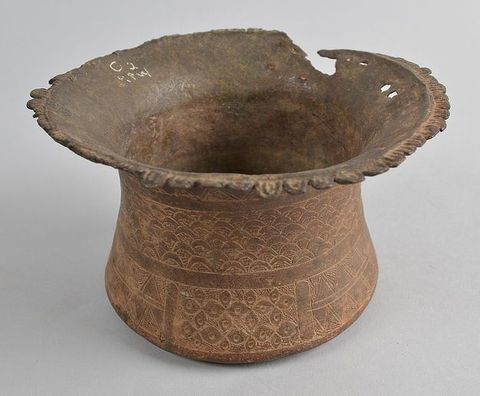
Even as the expansionist Asante Empire was reorienting toward coastal trade and Atlantic networks during the eighteenth and nineteenth centuries, the north remained important as a place of potent esoteric learning and expertise, particularly around textiles.75 Akan groups often regarded objects originating in the north as having sacred associations.76 Throughout this period, the north had a specific valence in Asante culture, not simply as a borderlands area but with a sense of the exotic and ritually powerful. For example, the nsaa (artisanship) adinkra sign refers to the sacred nsaa wool cloth that came to Asante as tributes from sites in northern vassal states, such as Salaga in the Dagomba kingdom, and which was valued for its northern origins (see Sallagha and Dagwumba in fig. 2).77 Additionally, oral histories recount the origins of the Asantehene’s wardrobe mistresses in the Asante conquest of the northwestern Akan kingdom of Techiman.78 Furthermore Allison Martino points out that the materials for making adinkra stamps and dye also traditionally came from north of Kumase, reinforcing the association between adinkra and the north.79 Oral histories of adinkra note that it was integrated into Asante culture on the direct say-so of the Asantehene, through the acquisition of textile technologies and their associated sacrality as a form of war booty.80 We should also note that, like the British Empire, the Asante Empire was engaged in the trafficking of enslaved people—both domestically and through transatlantic routes—and key artisanal techniques were sometimes appropriated from the individuals enslaved by the Asante in conquered regions.81 Through conquest and migration as well as trade, Asante associations with the north encompassed goods, technical and artisanal skill, esoteric practices, and expert practitioners.
75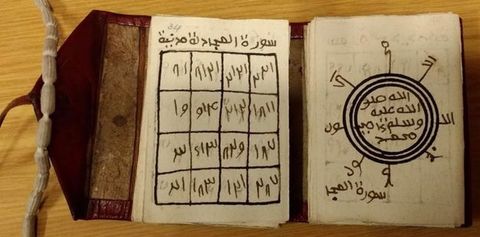

Beyond materials and techniques, engagement with the north also introduced visual forms, particularly Islamic motifs and talismanic structures, that informed adinkra cloth’s compositional logics. Beginning in the eighteenth century, the Asantehene invited Dyula (Juula) and Hausa merchants and artisans, Muslim scholars, and Islamic diviners to settle in Kumase, where the ruler relied on some of them as court scribes, advisers, and crafters of amulets and talismans (figs. 12 and 13).82 These amulets were often in the form of paper with Quranic inscriptions arranged in grids or other regular arrays, folded and encased in a pouch of leather, cloth, or embossed gold (fig. 14). Additionally, adinkra seems to draw on West African protective talismanic garments, which displayed Quranic verses as blocks of Arabic text along with magic squares and other protective diagrams (figs. 15 and 16).83 Given that the north was the origin of these amulets and talismanic objects, the Asantehene was thus harnessing the power of associations with the north to absorb esoteric power from the fringes of empire into the center—within Asante cosmopolitan practice.
82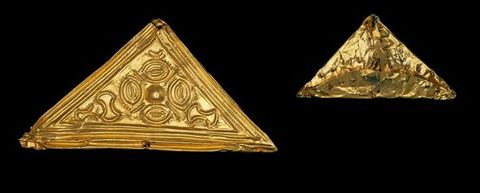
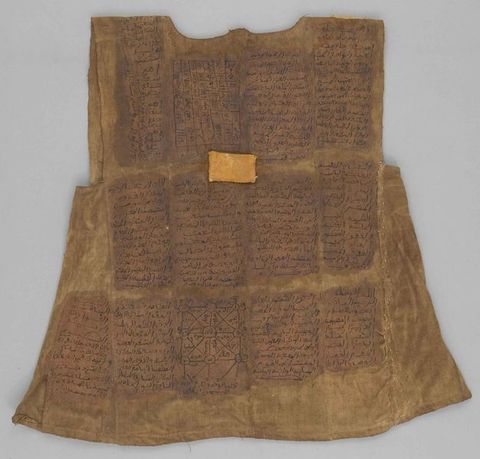
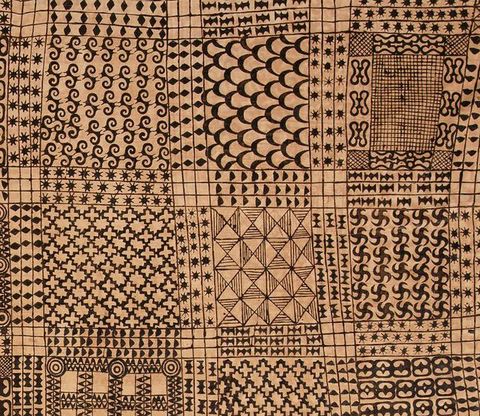
For Asante users, Islamic amulets were particularly useful as protective wear in wartime, supplementing Akan talismans and regalia to create visual arrays that expressed metaphysical power.84 Even though these amulets had their origins in Islamic traditions, the archaeologist Rachel Ama Asaa Engmann explains that Muslim scribes “satisfied non-Muslim Asante concerns, needs, and desires, by tailoring Islamic talismans to market demands” in Kumase and elsewhere in the Asante Empire.85 An image from Joseph Dupuis’s British diplomatic mission to Kumase in 1820 shows a caboceer, or Asante military leader, with a horse blanket covered in Arabic inscriptions (fig. 17). In one of Bowdich’s images, an Asante captain wears a cloth smock or vest “covered with fetishes and saphies in gold and silver; and embroidered cases of almost every colour … and they held a long iron chain between their teeth, with a scrap of Moorish [sic], writing affixed to the end of it” (fig. 18).86 The Asante captain looks to be wearing a batakari, or Asante war shirt, with numerous amulets affixed to it in a rough grid formation (fig. 19). The protective efficacy of these objects lay in Islamic and Akan visualities in an imperial display.
84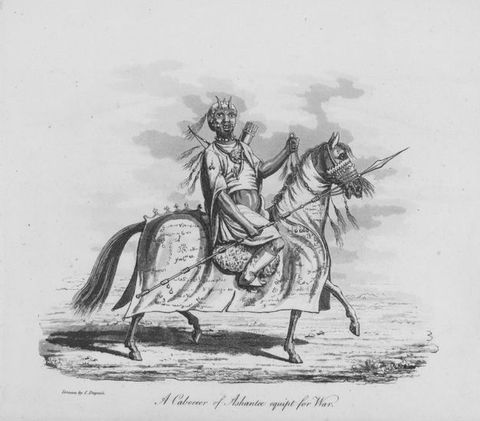
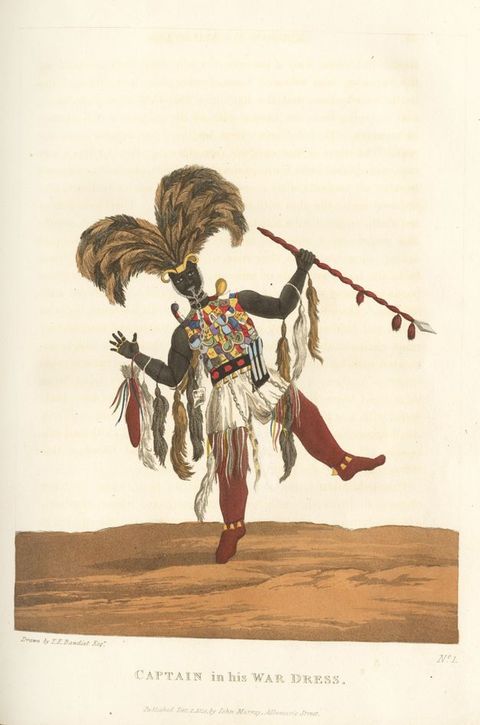
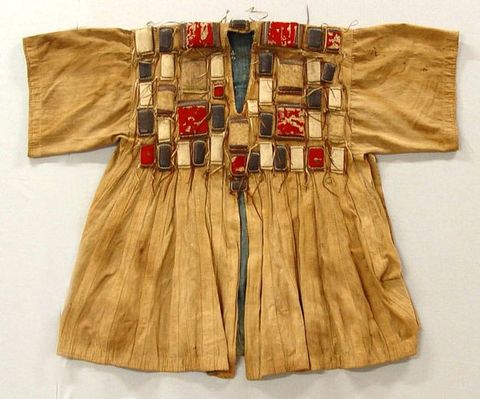
This connection to Islamic motifs is not fundamentally about the significance of individual adinkra symbols, nor only about the transformation of script into abstract artistic forms, but about overall compositions. As Savage points out, the symmetric geometries of amuletic inscriptions inform the arrangement of amulets affixed to batakari shirts and adinkra cloth design.87 Across Mamluk metalwork, kuduo vessels, inscribed amulets, gold amulet cases, and architectural relief, the motifs are contained by frames that situate each symbol—often repeated—within a broader matrix. With adinkra cloth too, the symbols are arrayed in meaningful juxtapositions, with narrower bands of repeated patterns between larger cells. Whether or not selected adinkra motifs can be traced to individual motifs in Islamic metalwork, scripts, or talismanic forms, these traditions share a gridded spatial logic, repetition, and emphasis on positionality in broader visual and material contexts.88 This esoteric knowledge intersects with spatial ordering in that sacred effects derive from, and are reinforced by, compositional logics of the grid, geometries, and framing.
87Unfolded: Asante Architectures
Adinkra motifs function as a reservoir of imagery deployed across textiles, amulets, goldwork, and Asante architecture.89 In eighteenth- and nineteenth-century Kumase, red earth foundations and adampan reception rooms reflected traditional Akan architecture, while abstract wooden window screens (nkyimkyim) and architectural decorations originated in the Islamic north (fig. 20).90 Hanging talismans signified Asante’s cosmopolitan connections to the foreign prestige of Dyula traders and court scribes, while the nkyimkyim screens puncturing Kumase’s earthen facades incorporated references to Islamic script to harness the “apotropaic power of foreign elements” on the scale of an entire building.91
89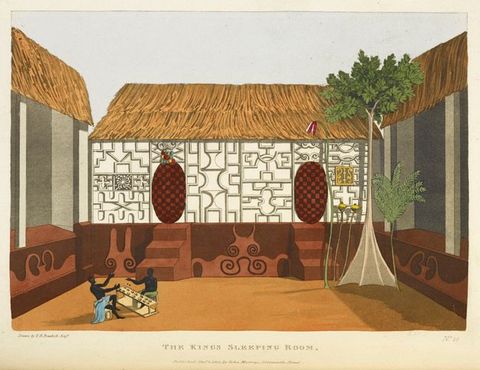
Additionally, Asante architecture featured handmade decorative reliefs incorporating motifs that echo adinkra forms and Islamic ornamentation, juxtaposed with the gyase dua tree, marking Asante settlement (see fig. 17). In Mission from Cape Coast Castle to Ashantee, Bowdich described the production of these reliefs:
92The walls still soft, they formed moulds or frame works of the patterns in delicate slips of cane, connected by grass. The two first slips … projected the relief, commonly mezzo: the interstices were then filled up with the plaster, and assumed the appearance depicted. The poles or pillars were sometimes encircled by twists of cane, intersecting each other, which, being filled up with thin plaster, resembled the lozenge and cable ornaments of the Anglo-Norman order; the quatre-foil was very common, and by no means rude, from the symmetrical bend of the cane which formed it. I saw a few pillars, (after they had been squared with the plaster) with numerous slips of cane pressed perpendicularly on to the wet surface, which being covered again with a very thin coat of plaster, closely resembled fluting.92
For the architectural historian Labelle Prussin, these “arabesque” surface motifs showed the Asante Empire’s emphasis on Arabic script as a way of visually reinforcing the architectural qualities of “enclosing arts”, or the building as a protective envelope.93 For Prussin, the “visual, magical efficacy of the written word which historical development carried in from the north” was “incorporated into the existing wattle-and-daub structure” of Asante architecture and “became a catalytic agent in the transformation of an aesthetic”.94 Similarly, Savage calls the transfer of talismanic forms from paper to earthen architecture and textiles a form of protective “social wrapping”.95 Both scholars point to the protective power of amulets worn on one’s person, and of talismanic garments that enfold the body, expanding to the surrounding buildings. These enveloping principles also shaped Kumase’s imperial architecture.
93As the Asante Empire consolidated, imperial power was materialized in ways that combined wrapping or enveloping techniques with public-facing architectural formats. Rather than Asante architecture’s traditional interior-facing, raised reception rooms, Prussin writes, Kumase’s adampan reception rooms began to face outward: “This architectural reversal, reflecting the increasingly complex functions of the capital … politically instituted festivals, and the ritual formalities associated with them, ushered in a new system of visual communication”.96 As visualized in Bowdich’s drawing of Adoom street, the architectural historian Kevin Dumouchelle describes this as part of Kumase’s “hyper-Asante” architecture: buildings are “raised on a platform marked by its distinctive, ochre slip. A profusion of abstract decorative reliefs draws the eye across the surface of the buildings”, and the adampan are unusually public-facing and feature “exaggeratedly high roofs” (fig. 21).97 In these overstated architectural details and atypical openness toward the city, Dumouchelle sees a performance of Asante identity in the service of establishing national unity: “Literal stage sets upon which political discourse and the administration of empire was daily performed, these structures served as architectural tools of national cohesion”.98 Moreover, Prussin argues, like the Arabic script openly worn by the war captain, these architectural decorations bring secret, enveloped amuletic powers into open view.99 Northern-inflected artisanship in architectural decoration, talismans, and textiles operate in cross-medial dialogue to show Asante cosmopolitan accumulation as a visual demonstration of imperial power predicated on formal strategies of surface composition. These strategies also unfolded at the scale of the city.
96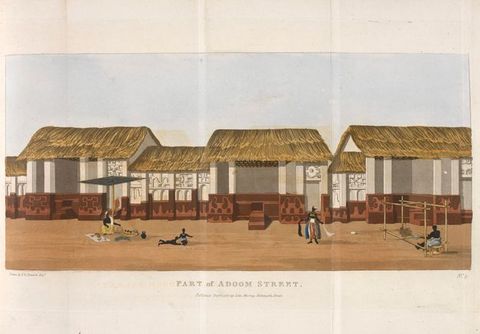
Through the streets of Kumase, varied aesthetic forms, craft expertise, and technical skills—displayed on the walls of its buildings, adorning the bodies of its inhabitants, and on show in the marketplace—demonstrated the geographical reach of the Asante Empire and its harnessing of exogenous powers. What was unique about the Asante Empire, as the historian Kwame Arhin has written, was not a specific innovation but the drawing together of diverse inhabitants, “and the consequential cross-fertilization of the skills imported from the different sources”. Arhin describes the objects that made up the visual and material culture of the city, including blacksmith’s wares, goldwork, leather sandals and sheaths, ceremonial whisks and cushions, dyed cloth, and vibrant umbrellas.100 This was evident in the marketplace, as Bowdich’s book shows: his image of Adoom street features a man weaving, a “fetish woman” carrying horses tails, and a woman holding gold scales with clay pipes on her sales mat (figs. 22–25). Extending this imperial visuality to the city space, we can see nineteenth-century Kumase as a place where objects from the corners of the Asante Empire came together in a visual interplay that emphasized the city’s cosmopolitanism and the Asantehene’s imperial reach.
100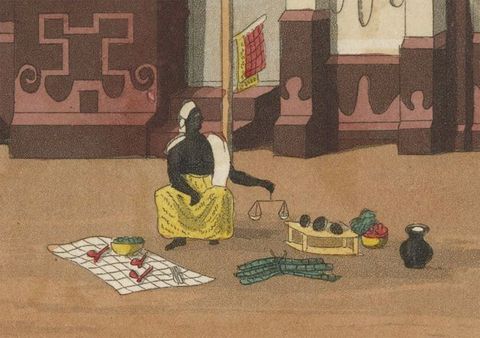
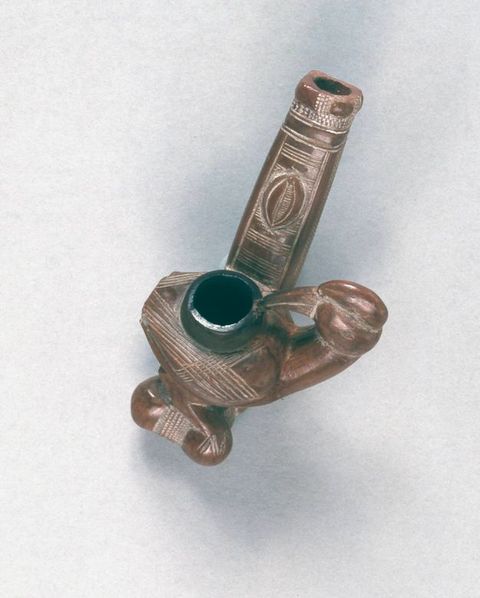


As a mourning fabric, adinkra cloth would presumably be present only intermittently in these urban contexts. Yet even if adinkra textiles were not everyday garments, they were present and visible enough for Bowdich to observe their production—albeit perhaps from a distance—as he claimed they were painted with a feather rather than stamped. Bowdich’s discussion of adinkra cloth, “principally manufactured in Inta [Gonja] and Dagwumba”, also suggests that he may have commissioned the painting of the adinkra design in Kumase: “There will be a very fair specimen in the British Museum, the price of painting which was one ackie”.101 This helps explain the limitations of Bowdich’s interpretations of adinkra, since he encountered the textile as a commodity rather than in the context of its use as mourning attire. Because commerce was the primary goal of Bowdich’s mission, he sought to acquire objects that exemplified technical developments and local manufacturing processes.102 Yet adinkra’s visual vocabulary extended well beyond portable commodities such as cloth.
101Visible in molded decorations on buildings and other objects, adinkra’s broader image trove permeated Asante.103 Prussin argues that the association of adinkra, architecture, and talismanic protective enveloping is supported by how adinkra symbols refer to architectural principles such as aban (two-story house, or seat of government) and mframadan (wind-resistant house).104 The links between architecture, Islamic amulets, and adinkra fabric can be seen in late nineteenth-century photographs of the northern town of Bonduku (likely founded as a successor to the Dyula trade town of Begho, and located in the present-day Ivory Coast) that show an interplay of textile, architecture, gold weights, and practices of inscription (figs. 26 and 27). Individuals clothed in patterned textiles—including a man dressed in adinkra cloth—handle gold weights whose forms may echo the fabric on which they rest, or inscribe paper (perhaps with talismans) while sitting beside a stool with carved patterns, in architectural surroundings decorated with further permutations of abstract forms. Talismanic inscriptions came into being in dialogue with their surroundings, mapped out into orderly gridded squares before being concealed in folded and wrapped containers. Similarly, the adinkra symbol nsaa can be seen in an adinkra stamp, a nsaa-shaped goldweight used to sell gold, Kumase architectural relief, and a Dagomba-style leather bag that Bowdich collected—items that could have been seen in public places around Kumase (figs. 28–31; see fig. 2).
103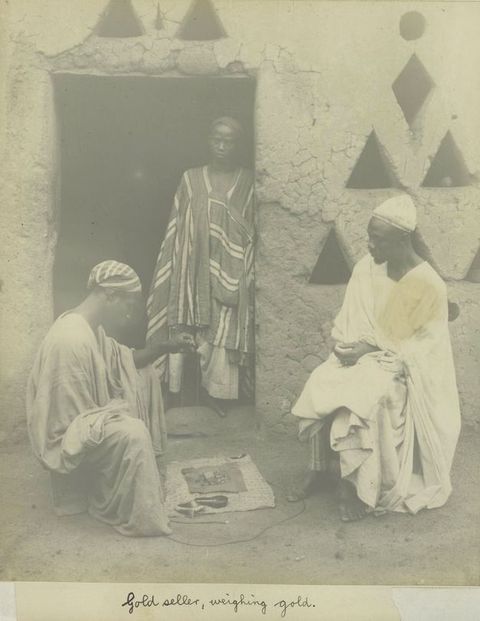
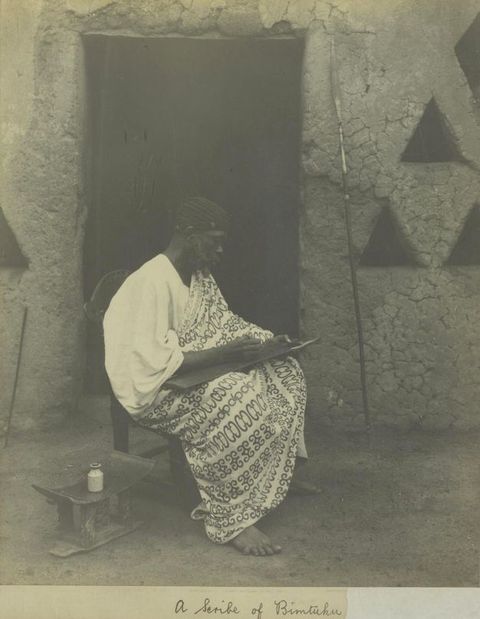
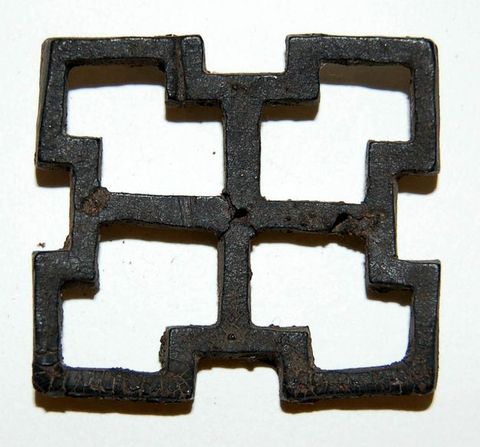
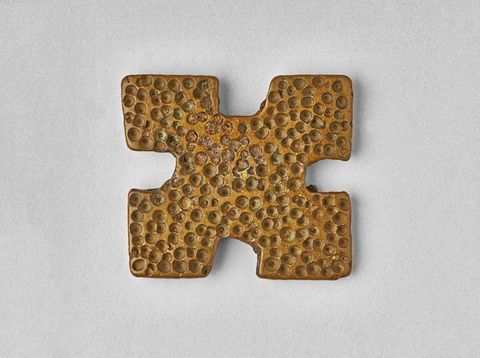
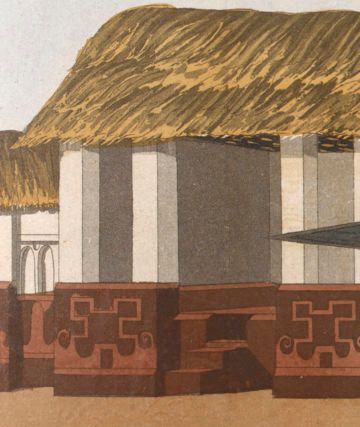
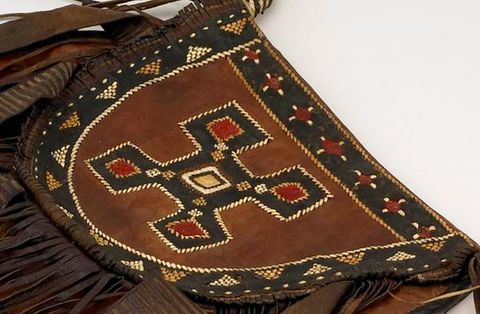
By the early nineteenth century, when Bowdich visited Kumase, the appropriation of foreign elements had extended to European practices. European guns hung on the Kumase palace walls, which Savage proposes were acting in parallel with amulets to cast a protective envelope around the royal residence (fig. 32).105 The illustration shows European weaponry displayed as part of an ensemble of earthen architecture adorned with abstract designs, while the soldier standing before the building wears blue-and-white-striped cloth that may have originated in Benin, Bonduku, or India, or be a locally rewoven assemblage.106 Since the Asantehene’s power was predicated in part on maintaining the ability to carry out trade, this abundance in the marketplace is also a form of imperial display.107
105
Beyond the marketplace, palace architecture also demonstrated imperial reach. When Bowdich came to Kumase and spoke of a museum, an institution that gathered impressive objects from all over the world to place them on display at the center of the British Empire, it would have been intelligible to the Asantehene and in keeping with the cosmopolitan character of the capital city itself.108 Perhaps prompted by Bowdich’s accounts of his homeland, the Asantehene began planning a European-style stone building, which would later house the Asante imperial collections. Bowdich remarked that “the King made frequent enquiries about the architecture of England, of which we gave him some idea by drawings”.109 A few years after Bowdich’s visit, the British consul Joseph Dupuis observed the construction of Kumase’s new European-style stone palace complex. “I am building”, the Asantehene is quoted as saying,
108110a fort like Cape Coast Castle; but I shall make it very high that I may look out and see all the town … That building you see is to be made very grand. The inside shall be gold, ivory, and brass … all the black countries may know I am a great king here. Now white men know me, I must live in a great house as white kings do.110
The resulting multistory stone structure, named the Aban likely from the Mande term al banna (based on an Arabic term for builder), was built by (possibly enslaved) Fante masons contracted through Dutch middlemen. While one British visitor called it “Moorish in its style”, the Asantehene asserted that it emulated the European architecture along the West African coast.111 As evidenced in text and images by British visitors, and reported statements by the Asantehene, the Asante imperial imaginary synthesized diverse forms of artisanship into a pageant of consumable objects.112
111By the early nineteenth century, Kumase’s urban and architectural landscape was demonstrating how the Asante Empire had gathered and synthesized diverse artisanship, material forms, and protective symbolism—from Islamic talismans and northern strip-weaving to European firearms and architectural models—to project authority, unity, and cosmopolitan reach. These objects and visual practices were not only performative within the city but also circulatory: they could be mobilized, displayed, and exchanged beyond Asante territory. The Aban drew not only on northern and Islamic influences but also on European ones along the Atlantic Coast and beyond, and its contents would ultimately include items from North Africa and Europe as well as from closer neighbors. This was a cosmopolitanism akin to Traoré’s disenclavement.113 Reorienting away from the north, and toward the Atlantic Coast and beyond, Asante’s empire building expressed its shifting imperial geographies visually and materially.
113Bowdich’s mission to Kumase, aimed at acquiring local artisanship for potential European trade, reveals how Asante material culture was already legible as both a marker of imperial power and as a commodity within global networks. Once these objects entered British possession, however, they were reframed according to a different logic of empire, transformed from instruments of Asante authority and cosmopolitan display into objects of curiosity at the British Museum.
Encased: In the British Museum, of the Global Empire
On returning to England in 1818, Bowdich presented many of the objects he had collected in Asante and Gabon to the British Museum, where they were installed in glass cases alongside items collected on other expeditions or military operations across the globe (figs. 33–35). It is not clear how, or even whether, the objects from Asante were displayed immediately after they entered the collection, but by 1832 they were housed in Room 1 of the generically named Upper Floor of the British Museum at Montagu House. On the lower floor was the Gallery of Antiquities, then expanding with the construction of a tailor-made room for the Parthenon marbles, alongside the museum’s collection of Egyptian, Greek, and Roman sculptures; ancient and modern coins and medals; and prints and drawings, including the Cracherode collection of sixteenth- and seventeenth-century works by Dürer, Claude, Holbein, Rembrandt, Rubens, and Marcantonio, among others.114 There was a clear spatial division between the artistic items in the Gallery of Antiquities and the natural and artificial “curiosities” and minor arts in the section labeled simply “Upper Floor”.
114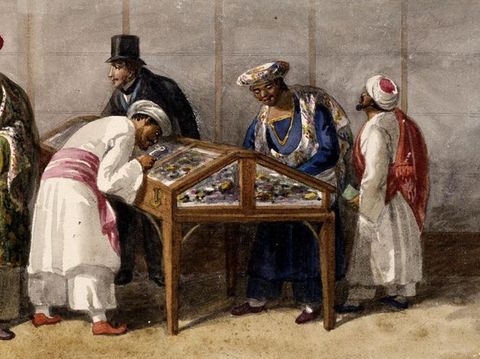
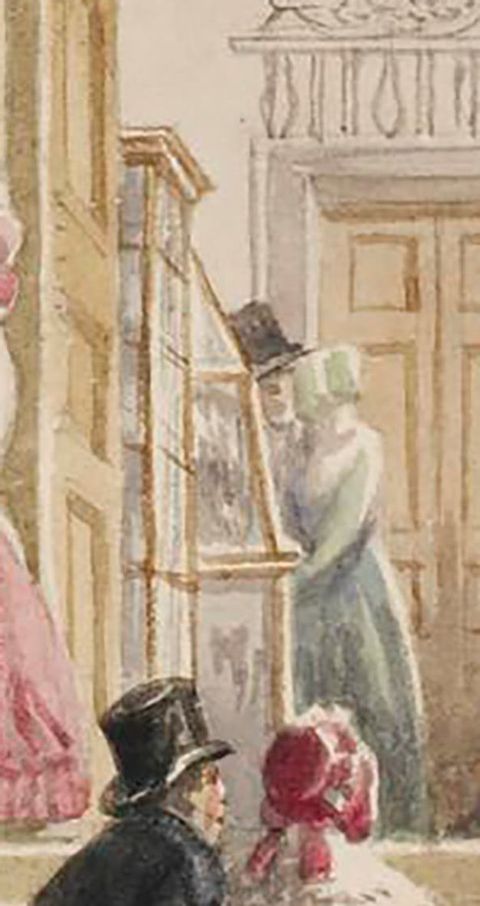
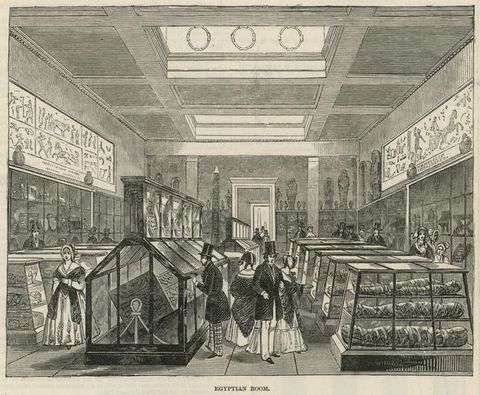
Within this Upper Floor, there were further divisions, with collection categories including “Artificial Curiosities from different Countries”, as well as botanical volumes, ancient seals and bronzes, and collections of reptiles, fish, and corals (fig. 36).115 The items from Asante were located in Room 1, alongside other “artificial curiosities”, meaning human-made items (as opposed to “natural curiosities”) from far-flung locations.116 Asante items were displayed in cases between a Fula cloak, Kawésqar or Yahgan birch bark-and-reed baskets from Patagonia, and other items organized according to the donor, many of them ship’s captains or named explorers such as Captain Cook. These displays presented objects as evidence of far-flung exploration in the service of British imperial expansion. Room 1 case labels sometimes noted the ethnic or group identities of the objects’ creators, while in other instances only the collection location was given. Many of the individual donors mentioned were officers in the Royal Navy on “expeditions” in the Arctic, South America, or South Pacific; this demonstrated the links between British museum collections and British military operations.117 Others were connected to one of the English mercantile companies, including Bowdich, who aspired to a position with the Africa Company in Asante, and G. A. Princep, a business owner and the son of an East India Company shareholder in Mumbai.118 The “artificial curiosities” room offered a geographic snapshot of Britain’s imperial ambitions in the early nineteenth century, with Asante as one node of the nascent empire.119
115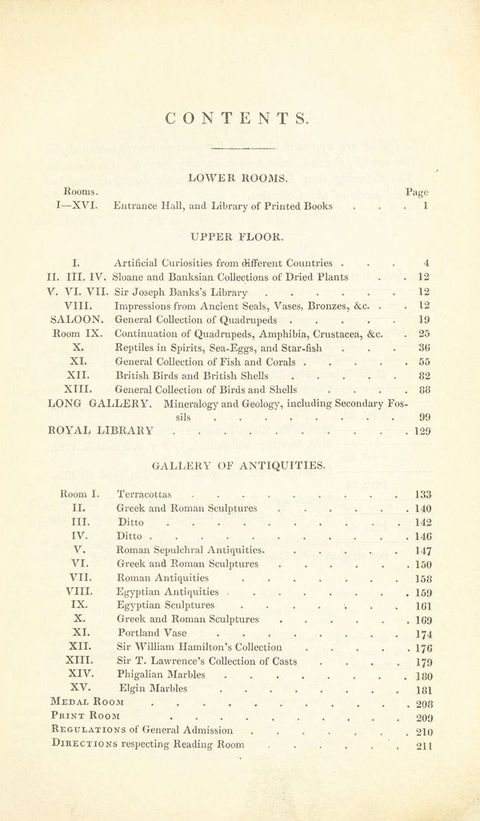
The “artificial curiosities” in Room 1 were differentiated from other objects not only by geography, but also according to the primitivizing organizational logics of the British Museum. Art from India, for example, was more easily assimilated to antiquarian art objects, such as Egyptian, Greek, and Roman items in “lesser” materials such as terracotta, glass, and metal.120 In contrast, an 1832 guide to the British Museum called Room 1’s contents—including the Bowdich donation—“artificial curiosities from the less civilized parts of the world”.121
120This foregrounding of origins was somewhat different from a parallel project occurring at the Musée Napóleon in France around the same time. In addition to the well-known plunder of North African sites such as Dendera, the Napoleonic army’s military looting led to the acquisition of myriad objects for the French state from European sites such as Kassel, Spanish Naples, and The Hague.122 As the art historian Bénédicte Savoy has concluded, the inventory at the Musée Napóleon—perhaps the first modern museum database—worked to obscure the origins of objects. Rather than geographic origins, cultural authorship, or aesthetic categorization, the inventory emphasized the site of military confiscation, thus naturalizing the objects’ appropriation and nationalization by the French state.123 In the British context, however, guidebooks and synopses of the collections did not conceal so much as blur the longer provenances of objects with their far-flung origins, highlighting how the nascent empire was being stitched together.
122As the British Museum expanded its collection in the early nineteenth century, each addition provoked a new configuration of objects, with categories reconceptualized according to the shifting geographies of natural history, ethnography, and fine arts. Changing categorizing systems and understandings of objects unfold across different editions of Synopsis of the Contents of the British Museum spanning the first half of the nineteenth century. Across this time, objects from West Africa, as well as human-made objects gathered on expeditions and “artificial curiosities from the less civilized parts of the world”, were included among minerals and fossils.124 Beginning in the 1840s, objects obtained in Asante were housed in what was newly labeled as the “ethnographic room”, alongside cases with objects from China, northern India, Afghanistan, French Guiana, and (Indigenous) North America, among others, and by 1860 Asante items were rarely mentioned.125 This shift simultaneously shows Britain’s imperial expansion and the shift in framing of African works from curiosities to ethnographic objects.
124By moving from a cabinet of curiosities model toward a museum with distinct zones for ethnography and the fine arts—later divided between different museums—the 1840s British Museum display was catching up with Bowdich’s 1819 book, Mission, which combined ethnographic attention and mercantile assessment of craft, and pointed to the excellent examples of artisanship he was setting aside for the British Museum. Images in the book reaffirmed this frame by showing a weaver at his loom (artisanship) and a woman with wares set out at the market (commerce) (see fig. 22). Bowdich also discussed the potential for gold mining in the interior, noted the local demand for guns and powder, and suggested that Manchester cotton might fulfill a market niche in Asante.126
126As Savage and McLeod point out, the range of objects that made their way from Kumase to the British Museum were artificially narrow—excluding items of European manufacture commonly owned and traded in Kumase at the time.127 Yet they also revealed the Asante Empire’s links across the Sahel and Sahara to the Mediterranean and North Africa. Bowdich explained in his book that many of the objects he had obtained were produced wholly or in part outside the Asante Empire, or were crafted by non-Asante artisans in Asante; for example, “The locks they use are from Houssa [Hausaland] … one will be sent to the British Museum … White cloths, which are principally manufactured in Inta and Dagwumba [Dagomba], [the Asante] paint for mourning with a mixture of blood [sic] and a red dye wood … There will be a very fair specimen in the British Museum”.128 (Additionally, the dagger and sheath, also included in “all from Ashantee”, may actually be items Bowdich purchased from Ongom/Bakele artisans in Gabon on his way back to England from Kumase.129) During his travels, Bowdich did not simply document everything he encountered in Kumase but actually omitted European objects in favor of Asante’s complicated geographical entanglements within Africa. Once these objects entered the British Museum, however, they were reduced to “all from Ashantee”—first as evidence of an expeditionary framework related to “negotiation with our new allies, the Ashantee”, and then as an ethnographic museum strategy.130
127Flattened: In the Art History Book
In addition to contributing the first substantial group of works from sub-Saharan Africa to the British Museum, Bowdich also produced what is perhaps the first proposal for a pan-African history of art—albeit with a problematic diffusionist narrative. Just two years after his first book, Bowdich published An Essay on the Superstitions, Customs and Arts, Common to the Ancient Egyptians, Abyssinians and Ashantees, in which he seeks to historicize Asante arts as an outgrowth of ancient Egypt and Ethiopia (Abyssinia): “this little Essay will prove, by a variety of curious evidence, that Abyssinia is not the only part of Africa which has been partly civilized by an intercourse with colonists and emigrants from ancient Egypt”.131 Notwithstanding the pejorative diffusionist framework, namely the idea that Asante culture originated with “the civilized Ethiopians of Herodotus and Diodorus”, Bowdich seriously considered the art of multiple African cultures and their histories across an expansive geography.132
131To make his argument, Bowdich needed to move away from the ethnographic style of Mission, which depicted the objects from Asante within a complex web of visual and behavioral associations.133 Instead, Superstitions adopted the conventions of early-nineteenth-century scientific illustration.134 Through his wife, Sarah, Bowdich enlisted the artist Jane Landseer to visit the British Museum and produce close-up watercolors of the objects “from Asante”, after which Sarah Bowdich redrew them in preparation for print.135 The result is a page spread of objects floating on blank backgrounds.
133The formal arrangements of the Superstitions images foreshadow the standardized, neutral backgrounds of modern museum photography, as seen in twenty-first-century images of these same objects in the British Museum collection (fig. 37). Scattered across a blank page at disparate scales are lithographic images of these items, plus a design labeled as “part of the pattern of a painted mourning cloth”, that is, adinkra (annotated in the image with a “13”).136 The following pages depict “Ashantee Architectural Ornaments” as linear forms, with gradations of line weight to suggest slight relief on a blank background (fig. 38). (The book illustration omits several additional items Bowdich presented to the British Museum, including gold discs and amulet cases, additional lengths of cloth, a foot loom, a parasol, and arrows.)
136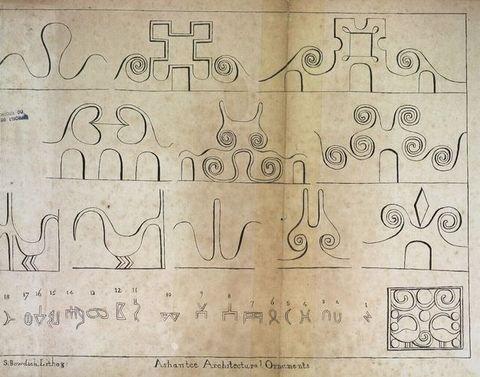
This decontextualization of objects from Asante is most blatant in the case of the adinkra cloth. As Savage has shown, Sarah Bowdich composed the lithograph in Bowdich’s book by combining Landseer’s watercolor images of single isolated objects.137 In Landseer’s watercolors objects are oriented horizontally or vertically as if placed on a table or shelf, and usually include shadows. However, in the book the objects float askew at various scales, with shading omitted to remove any sense of the objects’ spatial context. The adinkra textile, for example, is not only plucked from its setting, but becomes a fragmented set of isolated forms applied directly to the page, with no edges, denied even the semblance of materiality. The adinkra design is also removed from any relationship to the bodies of people who may have worn it, just as the architectural decorations are excerpted from larger patterns on buildings.
137In one sense, Bowdich’s book enacted a familiar process of modern Western scholarship, of withdrawing objects from their lived context and placing them against a supposedly neutral backdrop to appreciate their scientific data or their formal, aesthetic qualities. The philosopher V. Y. Mudimbe has described the integration of “primitive” art into the “Western tradition” as precisely this two-step process: first, ethnologization, “isolating a datum from its real context” and analyzing it, which renders it capable of being “subsumed to the grids of ethnographic study”; then, aestheticization, whereby a work is “localized on a chronological scale determined by Western experience”.138 For the art historian Kobena Mercer, African objects in Western collections are continually undergoing a “process of decontextualization set in motion by colonial uprooting”, which is perpetuated in the space of the museum.139 Mercer focuses on the aestheticization of the modernist white cube museum space, but this decontextualization had already begun in the earlier institutional spaces of the museum and the (proto-)art history book.
138The objects from the Asante Empire entered the British Museum prior to a hardening of conventions of collection and display for “non-Western” objects.140 At the early nineteenth-century British Museum, objects were clustered in the museum’s glass-fronted wooden cases, sometimes according to their function but often according to geography and even specific expeditions, more in line with a cabinet of curiosities model than with the emerging modern museum.141 These objects entered the space of a British Museum that was still being formed, with collections not yet divided into orderly categories of natural history, ethnography, and art, each with its own internal conceptual logics, partitions, and exhibition design. The objects set against the neutral background of Bowdich’s blank page did not anticipate a white cube museum space—the British Museum was then housed in a building adapted from a seventeenth-century aristocratic mansion—nor did they match the clusters of objects on shelves in the British Museum cases.142 Instead, Bowdich’s book functioned as one proposal for how these objects might enter British intellectual life. Still, Bowdich relied on the museum’s decontextualizing logic: foregrounding his authorship of the Asante collection allowed for the label “Asante” to assume greater importance than the individual attributions.
140Formally, Bowdich modeled his book on contemporary archaeological reports such as Frédéric Cailliaud’s investigation of Thebes, which removed isolated objects from their settings and depicted them at disparate scales on blank backgrounds (figs. 39 and 40; see figs. 37 and 38).143 Bowdich was particularly struck by Henry Salt’s voyage through Abyssinia, which served as a direct model for his investigation of architectural ornamentation in Asante (figs. 41 and 42).144 Bowdich followed Salt’s model in page spreads of decontextualized architectural ornaments, and in Superstitions he laid out a typology of Asante architectural motifs, which he compared to an array of inscriptions in stone at Axum, Ethiopia, in the lower part of the image (see fig. 38). While it was most likely Sarah Bowdich who composed the individual images, Bowdich’s text shows that he thought strategically about how images could be used as evidence and was instrumental in crafting the overall book structure. Generally, he sought to emulate Salt’s studies and to contribute to broader intellectual debates around cultural diffusion across Africa. To do so, he proposed this formal argument about the relationship of Asante ornamentation to Egyptian precedents:
143145The freedom and simplicity of the larger ornaments of the Ashantee architecture are truly Egyptian, originating from the calyx or corolla of a flower, as Denon suggests, or from the young leaves of those immense palm-like filices, representing, at their birth, the voluta of the Ionic capital, of which they are supposed to have furnished the idea.145

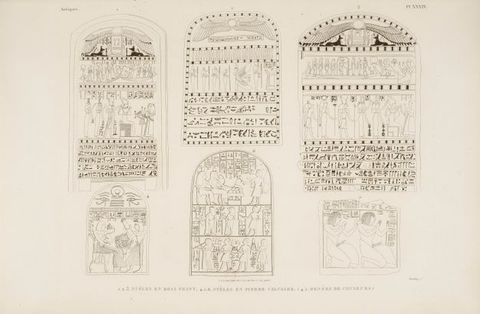
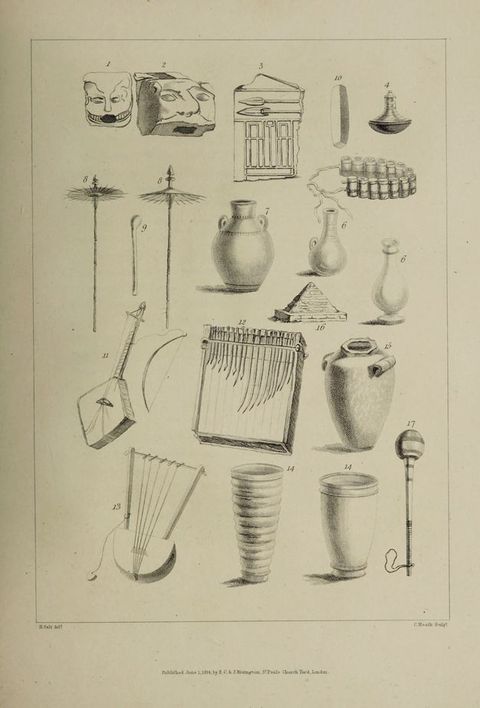
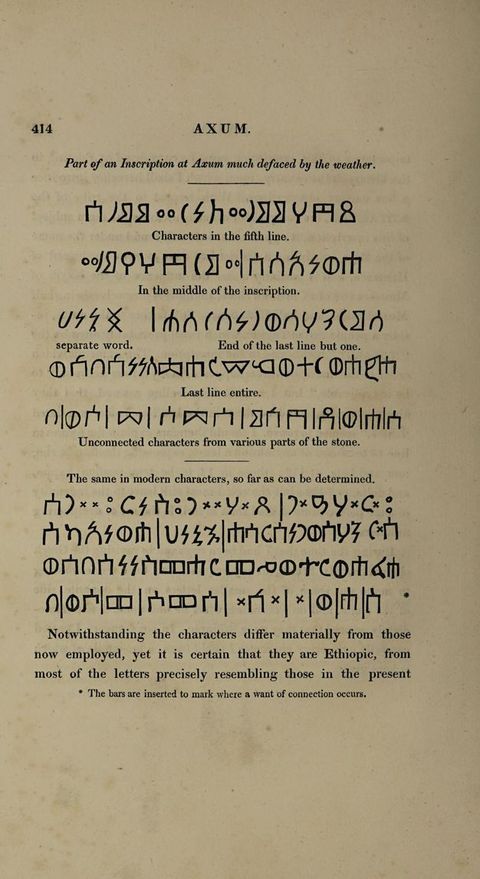
While Bowdich emulated expeditionary journals by archaeologists, his discussions of patterning also seem to presage the decontextualized modes of nineteenth-century Western design theory and the formalist art history later formulated by Alois Riegl, among others.146 In Riegl’s theoretical text Stilfragen (1893), for example, in which he advanced a theory of stylistic development, much of his evidence is offered as decontextualized line drawings of forms excerpted from relief sculptures and architectonic complexes (fig. 43).147 Bowdich used the tools of formalist art history, avant la lettre, to support a historical lineage from Ethiopia to Asante.
146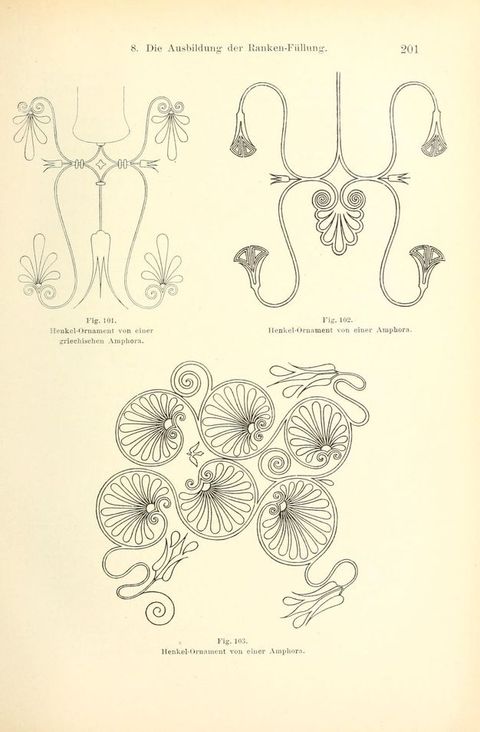
Bowdich’s Mission, the objects he presented to the British Museum, and Superstitions thus broadly map out the museological and art historical trajectory described by Mudimbe and Mercer. Where non-Western works were first reframed by the modern museum according to imperial cataloging and systems of display, decontextualized forms were later widely disseminated in pattern books. Nineteenth-century designers and architects assembled repertoires of “exotic” forms for deployment as isolated motifs and in formalist art-historical methodologies. Contrary to some conventional understandings of formalism, this is not simply a path toward the neutralization of origins and identities in favor of a universalist interpretation of form. As Margaret Olin, Éric Michaud, and others have shown, formalist methods of comparison are contingent on attributions according to perceived origins or identities (e.g., “Greek” versus “Egyptian” approaches to foliage), which often have racial implications.148
148While Mission carefully discerned the creator of each object across the Asante Empire’s multiethnic subjects, Bowdich’s next book, Superstitions, simply credited everything he saw in Kumase to Asante Akan makers within an argument about pan-African cultural forms. Admittedly, Mission similarly genericized the individuals using, wearing, or making the objects but, still, it showed objects in use with some identifying details.149 In contrast, Superstitions removed objects from the social, political, economic, and environmental contexts in which they had been produced and used, and even from their underlying material matrices of woven cloth and plastered wall. While the earlier volume had worked to promote his successes as an Africa Company bureaucrat, the second was published after he had left the company. Even while it reiterated his expertise on the Asante Empire, it was intended to position him as an independent scholar working at the nexus of the museum and the field.
149Bowdich’s argument relied not only on works being removed from their origins and entering the European museum, but also on the museum’s reshuffling of categories toward simplified geographical origins. Subsequently, Bowdich worked from images of the objects, reproducing them as disembodied forms in the pages of a book—in support of a unified history of African art. This is perhaps most evident in relation to the geometric patterning found as architectural details and on adinkra fabric, whose repeated iconic forms are particularly vulnerable to material mutability and spatial mobility. Recognizing that origins and identities are themselves constructed and contingent, we can understand the displacement of these objects from Kumase to the British Museum as only one in a sequence of recontextualizations.
Epilogue: Photographing Adinkra
The early nineteenth-century translocation of Asante objects, particularly adinkra cloth, from Kumase to the British Museum does not only exemplify a shift from one imperial context to another, but also shows how “African art” was invented through the collision of multiple imperialisms. From Kumase to London, imperial collections evinced changing political conditions in both the Asante and British empires. In the early nineteenth century, the Asante Empire leveraged intra-African networks and external connections to elevate its profile on the global stage. British imperial officials recognized the Asante Empire as a trade partner, if not as a potential equal. This dual imperial dynamic meant that, while Bowdich’s collected objects exemplified the multiethnic Asante Empire, the British Museum’s classification systems tended to restrict Asante objects to ethnographic rather than artistic categories. By the late nineteenth century, however, European expansion in Africa was threatening Asante authority. This would come to a double climax in 1874, when British forces invaded and burned Kumase, and in 1896, when British forces deposed and exiled the Asantehene.150 As trade goods, spoils, or collections, the objects “from Ashantee” demonstrate dual imperial aspirations and legacies.
150The cosmopolitanism of Asante, even during its transition to the British Gold Coast colony, continued to challenge the notion of a static, monolithic African culture assumed by British imperial forces. For example, the Aban that the Asantehene had discussed with Bowdich and Dupuis in the 1810s and 1820s, was serving as what we understand to have been the Asantehene’s imperial museum (fig. 44). The Aban housed Asante’s heterogenous imperial collections and was open to visitors to Kumase, including European visitors to the city—until English imperial invasion and looting beginning in the mid-1870s. One account by a British participant in the 1874 Anglo-Asante War described the contents of the Aban:
151Books in many languages, Bohemian glass, clocks, silver plate, old furniture, Persian rugs, Kidderminster carpets, pictures and engravings, numberless chests and coffers. A sword bearing the inscription “From Queen Victoria to the King of Ashante”. A copy of the “Times”, October 17, 1843. With these were many specimens of Moorish [sic] and Ashante handicraft, gold-studded sandals such as only the king and a few great chiefs may wear, with, strange to say, Arabic writing on the soles; leopard-skin caps lined with yellow velvet and adorned outside with beaten gold like that of Cashmere, and a plume of the same precious metal; saddles of red leather, magnificent canopies or state umbrellas of velvet and satin, baskets or cradles in which Ashantee chiefs are accustomed to be carried on the heads of slaves, with other curious and tasteful things too numerous for me to describe or even catalogue.151
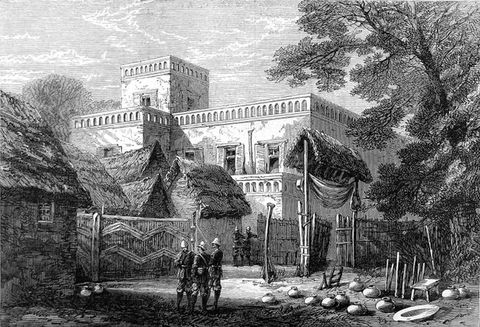
As the philosopher Kwame Anthony Appiah argues, this was a “splendidly cosmopolitan” collection.152 Asante’s practice of empire building encompassed a city and a collection that expressed its imbrication with counterparts across North and West Africa and Europe visually and materially. Yet, just as Bowdich ignored the European material culture present in Kumase when he gathered objects “from Ashantee” for the British Museum, the looters and recipients of Anglo-Asante War indemnity were not interested in Asante cosmopolitanism. Indeed, they had an even narrower view than Bowdich and valued only Asante goldwork.
152Over the decades of British repression of Asante forces and the absorption of Kumase into the British colony of the Gold Coast, the British Museum reframed Asante objects yet again. British Museum guidebooks from the 1870s and 1880s almost completely omitted the objects Bowdich had collected, naming only a single wooden stool or “carvings, cloths, etc.”, leaving out adinkra cloth entirely.153 By the late 1890s, after British looting and the beginning of punitive compensatory payments of gold imposed on the Asante, British Museum guidebooks separated a vague account of Asante “carvings, cloths, etc.” in the Africa ethnological gallery from “gold and silver ornaments … from Ashanti” in a room of “ornaments from various countries”.154 Adinkra cloth and other forms of Asante material culture were displaced by dazzling—and fungible—goldwork in British Museum presentations of Asante.
153As Asante transitioned into a de facto British colony, the framing of adinkra fabrics shifted again as it was shaped by missionary activities. By the early twentieth century, the Basel Mission had been in the Gold Coast region for almost a century, and had been collaborating with the British colonial administration for much of this time; it provided some supplies and support for the British penetration into Kumase in 1874.155 Thus, in the early twentieth century, adinkra cloth would still have been on display in Europe but not in the art museum. At the 1911 Exposition of the Basel Mission in Geneva, a Swiss missionary to Asante stood before a table and wall brimming with objects of all kinds, including several carved gourd adinkra stamps and an adinkra textile (figs. 45 and 46).156 Here, we return to the visual logic of the cabinet of curiosities, in which functional items such as pots and combs intermingle with examples of wood carving and textile work.
155

However, there is an additional piece of visual information. Tacked onto the center of the adinkra cloth is a photograph of the cloth being stamped (see figs. 5 and 6). Adinkra is no longer a potential commodity as it was in Kumase, nor is it an isolated formal motif as in Bowdich’s Superstitions, nor an intriguing object at the British Museum. The photograph, taken by a Swiss missionary, foregrounds artisanal creation within the missionary’s framing of the region as premodern.157 The Basel Mission exposition thus adopted a similar framework as Asante performances of culture at the 1886 Liverpool International Fair and in the “Ashanti Village” that toured the United Kingdom in the 1890s, staging seemingly guileless performances of cultural practices that presented the Asante people as susceptible to British intervention.158 Yet, in addition to these public entertainments, the Basel Mission was also collecting.159 In the same decades that British looters and colonial agents were obtaining Asante goldwork that would enter the British Museum, while largely ignoring ethnographic objects, the Basel Mission was acquiring ethnographic objects in the service of missionary work, many of which were later donated to Swiss ethnographic collections. In both cases, the effect was to deny the Asante access to modernity—to deny the Asante both modern artisanship, despite the growing prevalence of British machine-made adinkra-patterned textiles, and access to its own resources of culture and capital, its gold.
157The inclusion of Asante objects at the British Museum was not merely the result of British acquisition through purchase or gift; it was also a calculated strategy by Asante elites and rulers to assert the empire’s presence on a global stage. Asante rulers deliberately curated artifacts as expressions of cosmopolitan identity and imperial ambition. However, the British Museum subsumed such works under categories that reduced dynamic political and cultural negotiations to static representations of “Ashantee”, and later “African”, art. The translocation of adinkra cloth—with its deep connections to Akan funeral practices, collective memory, and symbolic communication—serves as a striking example of imperial collecting practices. Such practices not only appropriate material culture but can also distort and oversimplify dynamic interplays of culture and identity. This story is not just about the movement of objects but also about the power to define how histories are remembered and told. From Kumase to London, and from the Aban to the pages of Bowdich’s books, objects and practices brought together in Asante traveled along networks of empire, commerce, and scholarship—reminding us that the story of African art is not fixed but remains in flux between geographies and interpretations. As the legacies of these imperial entanglements persist in contemporary museums, we must ask: How can we reimagine museum spaces to reveal histories that colonial frameworks have obscured?
Acknowledgements
Thank you to José Lingna Nafafé, Tony Yeboah, and the anonymous peer reviewers for their critiques, which strengthened this article; to Baillie Card, Sarah Victoria Turner, Tom Scutt, and others at the Paul Mellon Centre for editorial and publication expertise that further refined the textual and visual argumentation; and to all my fellow participants and experts at British Art Studies and the Terra Foundation for American Art “Atlantic Worlds” virtual residency, where these ideas developed. Additionally, I thank the NOMIS Foundation and the Clark Art Institute for funding to support my research and writing.
About the author
-
Adrian Anagnost is Associate Professor of Art History in the Newcomb Art Department and Core Faculty in the Stone Center for Latin American Studies at Tulane University. Anagnost’s publications include Spatial Orders, Social Forms: Art and the City in Modern Brazil (Yale University Press, 2022), “Edo Spaces, European Images: Iterations of Art and Architecture of Benin” (with Manol Gueorguiev, Art Institute of Chicago, 2022), and “Antisocial Housing: Migration and Temporary Architectures in Berlin” for an ASAP/Journal dossier on “Precarity and Public Housing” (2023). Anagnost was co-leader of the 2025 NEH Landmarks grant “Bvlbancha Rising: Louisiana Cultural Heritage Sites and Climate Change Challenges”, although the program was cancelled by the US Department of Government Efficiency.
Footnotes
-
1
For approaches to defining and characterizing the Asante polity in this period, see Kwasi Ampene, Asante Court Music and Verbal Arts in Ghana: The Porcupine and the Gold Stool (New York: Routledge, 2020), xxx–xxxiii. In his 1819 and 1821 books, Bowdich mostly referred to the Asante polity as a kingdom, but in the 1819 book he occasionally called it an empire. On the items that entered the British Museum, see Thomas Edward Bowdich, Mission from Cape Coast Castle to Ashantee with a Statistical Account of that Kingdom and Geographical Notices of Other Parts of the Interior of Africa (London: John Murray, 1819), 147, 198, 268, 306, 309–11, 313, 332; and the plates and captions in Thomas Edward Bowdich, An Essay on the Superstitions, Customs and Arts, Common to the Ancient Egyptians, Abyssinians and Ashantees (Paris: J. Smith, 1821), 70–73. ↩︎
-
2
See Thomas Edward Bowdich, The African Committee (London: Longman, Hurst, Rees, Orme, and Brown, 1819), 79; and British Museum, List of Additions Made to the Collections in the British Museum in the Year 1831 (London: G. Woodfall, 1833), 118–19. In 1820 Bowdich had to request access to the items at the British Museum so that an acquaintance of his could make drawings of them for his 1821 book. Fiona Sheales [Savage], “Sights/Sites of Spectacle: Anglo/Asante Appropriations, Diplomacy and Displays of Power 1816–1820” (PhD diss., University of East Anglia, 2011), 283–84. ↩︎
-
3
On the histories of ownership, donation, and display of these objects, see Sheales [Savage], “Sights/Sites of Spectacle”, 276–87 and table 2; and Fiona [Sheales] Savage, “Collecting the Asante: African Agency in a Pre-colonial Assemblage”, Museum Worlds 3, no. 1 (2015): 37–50. Asante has also been spelled Ashanti or Ashantee, among other variations. The capital city has been written as Kumasi, Kumase, Comassie, or Coomassie. ↩︎
-
4
On problems of defining ethnicity and historical toponyms, see note 16 below. See Claire Bosc-Tiessé and Peter Mark, “Towards an Art History of Precontemporary Africa: Preliminary Thoughts for a State-of-the-art Assessment”, Afriques 10 (2019), DOI:10.4000/afriques.2651; Claire Bosc-Tiessé, “Le cartel des arts: enjeux d’histoire entre assignations ethnographiques et présentations muséales”, Afriques 10 (2019); Ugochukwu-Smooth Nzewi, “Anthropology as Practice: Artists of Africa and the Ethnographic Field in Contemporary Art”, in Alternative Art and Anthropology: Global Encounters, ed. Arnd Schneider (New York: Routledge, 2020), 27–34; and Sebastian-Manès Sprute, “Chaos im Museum: Bestandsaufnahme und Wissensordnung”, in Atlas of Absence: Cameroon’s Cultural Heritage in Germany (Berlin: Dietrich Reimer, 2023), 284–91. ↩︎
-
5
On inland trade, see Kwame Arhin, “West African Trading Settlements in the Asante Hinterland in the Nineteenth Century”, Institute of African Studies Research Review 5, no. 1 (1989): 1–20. On Fante trade, see Rebecca Shumway, The Fante and the Transatlantic Slave Trade (Rochester, NY: University of Rochester Press, 2011). ↩︎
-
6
This was true particularly after 1807, when the Asante embarked on a military campaign against the Fante-led coalition along the coast around the time that the British began establishing a formal colony. Shumway, The Fante and the Transatlantic Slave Trade, 10–11; Kwasi Konadu, “Euro-African Commerce and Social Chaos: Akan Societies in the Nineteenth and Twentieth Centuries”, History in Africa 36 (2009): 266–67. On Euro-African factors and trade agents, see Natalie Everts, “‘Because I am an Uitlander’: West India Company Servant Willem Huydecoper’s Clash with His Colleagues”, in Sources and Methods for African History and Culture: Essays in Honor of Adam Jones, ed. Geert Castryck, Silke Strickrodt, and Katja Werthmann (Leipzig: Leipziger Universitätsverlag, 2016), 130. ↩︎
-
7
Savage, “Collecting the Asante”, 38. The Danish royal edict that ended the trafficking of enslaved peoples in 1803 was Forordning om Neger-Handelen [Ordinance on the Slave Trade] (Copenhagen: P. M. Høpffner, 1792), https://www.kb.dk/e-mat/dod/130018500540.pdf. The parliamentary act that ended Britain’s trafficking in 1807 was the Act for the Abolition of the Slave Trade (1807), Public General Act, 47 George III session 1, c. 36, Records of the House of Lords (c1293-2019), Parliamentary Archives, HL/PO/PU/1/1807/47G3s1n60, 1807, https://archives.parliament.uk/collections/getrecord/GB61_HL_PO_PU_1_1807_47G3s1n60. On the ending of the Dutch trafficking, see Johannes Postma, The Dutch in the Atlantic Slave Trade, 1600–1815 (New York: Cambridge University Press, 1990), 289–91. Despite the end of the transatlantic trafficking, chattel slavery itself, including the kidnapping, capture, purchase, and sale of individuals, continued for some decades. On this transition, see Chima J. Korieh, “The Nineteenth Century Commercial Transition in West Africa: The Case of the Biafra Hinterland”, Canadian Journal of African Studies 34, no. 3 (2000): 588–615; Gareth Austin, Labour, Land, and Capital in Ghana: From Slavery to Free Labour in Asante, 1807–1956 (Rochester, NY: Boydell & Brewer, 2005), 46–47; Christopher Leslie Brown, “The Origins of ‘Legitimate Commerce’”, in Commercial Agriculture, the Slave Trade and Slavery in Atlantic Africa, ed. Robin Law, Suzanne Schwarz, and Silke Strickrodt (Rochester, NY: Boydell & Brewer, 2013), 138–57; Kazuo Kobayashi, Indian Cotton Textiles in West Africa: African Agency, Consumer Demand and the Making of the Global Economy, 1750–1850 (Cham: Palgrave Macmillan, 2019), 29–80; and Angus E. Dalrymple-Smith, Commercial Transitions and Abolition in West Africa 1630–1860 (Boston: Brill, 2019). ↩︎
-
8
See Eugenia Anderson, “Asante Imperium Expansion: Imperial Outlook and the Construction of Empire”, in The Asante World, ed. Edmund Abaka and Kwame Osei Kwarteng (New York: Routledge, 2021), 77, 80–84; Brandi Simpson Miller, Food and Identity in Nineteenth and Twentieth Century Ghana: Food, Fights, and Regionalism (Cham: Palgrave Macmillan, 2022), 121–23; Sheales [Savage], “Sights/Sites of Spectacle”, 277–79; and Malcolm McLeod, “Gifts and Attitudes”, in The Golden Stool: Studies of the Asante Center and Periphery, ed. Enid Schildkrout and Carol Gelber (New York: American Museum of Natural History, 1987), 184–91. On Asante diplomatic practices in the late 1810s, see Graham W. Irwin, “Precolonial African Diplomacy: The Example of Asante”, International Journal of African Historical Studies 8, no. 1 (1975): 84–86. ↩︎
-
9
Savage, “Collecting the Asante”, 43–48. ↩︎
-
10
Bowdich, Mission, 147. On the Asantehene’s intentions that Asante works be exhibited in a European museum, and at the British Museum in particular, see also Sheales [Savage], “Sights/Sites of Spectacle”, 277; Savage, “Collecting the Asante”; and Claude-Hélène Perrot, “Un musée royal au début du XIXe siècle en Ashanti: l’Aban”, Cahiers d’Études Africaines 39, no. 155–56 (1999): 875–84. ↩︎
-
11
“Ashantee Golden Ornaments and Trophies”, Illustrated London News, 23 May 1874, 487; British Museum, “Asante Gold Regalia”, Contested Objects from the Collection, The British Museum Story, 20 July 2020, updated 14 October 2024, https://www.britishmuseum.org/about-us/british-museum-story/contested-objects-collection/asante-gold-regalia. ↩︎
-
12
Malcolm McLeod, “T. E. Bowdich: An Early Collector of West Africa”, in “Collectors & Collections”, British Museum Yearbook 2 (1977): 83, 88–91, 93; Sheales [Savage], “Sights/Sites of Spectacle”, 151–52, 186–87, 280. While Thomas Bowdich’s wife, Sarah Bowdich (later Sarah Bowdich Lee), did not accompany him on the 1817 trip to Kumase, she played an active role in collecting items from her position at Anomabu Fort and Cape Coast Castle from September 1816 through March 1818. ↩︎
-
13
Bowdich was no longer mentioned in British Museum guides after 1860. For the British Museum categorization of the objects as “all from Ashantee”, see British Museum, Synopsis of the Contents of the British Museum, 26th ed. (London: G. Woodfall, 1832), 7, and later guides through the 1850s. Today, however, the British Museum more precisely notes locations and groups for “Made in”, “Made by”, and “Found/Acquired”; see, for example, “bag”, The British Museum, https://www.britishmuseum.org/collection/object/E_Af1818-1114-26. ↩︎
-
14
McLeod, “T. E. Bowdich”, 93–94; McLeod, “Gifts and Attitudes”, 184–85. ↩︎
-
15
Agnes A. Aidoo, “Order and Conflict in the Asante Empire: A Study in Interest Group Relations”, African Studies Review 20, no. 1 (1977): 1–36; J. D. Fage, “Upper and Lower Guinea”, in The Cambridge History of Africa, ed. Roland Oliver (Cambridge: Cambridge University Press, 1977), 494–96; Sidney Littlefield Kasfir, “One Tribe, One Style? Paradigms in the Historiography of African Art”, History in Africa 11 (1984): 163–93. ↩︎
-
16
On the challenges of defining the term “Akan”, see D. Kiyaga-Mulindwa, “The ‘Akan’ Problem”, Current Anthropology 21, no. 4 (August 1980): 503–6; and Ivor Wilks, “The State of the Akan and the Akan States: A Discursion”, Cahiers d’Études Africaines 22, nos. 87–88 (1982): 231–49. More generally on ethnicity and historical toponyms, see René Baesjou, “The Historical Evidence in Old Maps and Charts of Africa with Special Reference to West Africa”, History in Africa 15 (1988): 19–20; Sprute, “Chaos im Museum”, 284–91; and Nii Otokunor Quarcoopome, “Art of the Akan”, Art Institute of Chicago Museum Studies 23, no. 2 (1997): 135–37. ↩︎
-
17
Valeska Huber and Jan C. Jansen, “Dealing with Difference: Cosmopolitanism in the Nineteenth-Century World of Empires”, Humanity: An International Journal of Human Rights, Humanitarianism, and Development 12, no. 1 (2021): 42. See also Hermann W. von Hesse, “‘A Modest, but Peculiar Style’: Self-Fashioning, Atlantic Commerce, and the Culture of Adornment on the Urban Gold Coast”, Journal of African History 64, no. 2 (2023): 269–91. ↩︎
-
18
Savage, “Collecting the Asante”; McLeod, “Gifts and Attitudes”. ↩︎
-
19
Allison J. Martino, “Stamping History: Stories of Social Change in Ghana’s Adinkra Cloth” (PhD diss., University of Michigan, 2018), 150. On cotton textile production in West Africa, see Colleen E. Kriger, “Mapping the History of Cotton Textile Production in Precolonial West Africa”, African Economic History 33 (2005): 87–116; and Philip Atsu Afeadie, “Beginnings of Ewe and Asante Weaving”, Transactions of the Historical Society of Ghana 15 (2013): 27–38. ↩︎
-
20
G. F. Kojo Arthur, Cloth as Metaphor: (Re)Reading the Adinkra Cloth Symbols of the Akan of Ghana (Legon: Centre for Indigenous Knowledge Systems, 2001), 28–29; Nii O. Quarcoopome, “Akan Ceremonial Cloths, Costumes, and Flags”, Bulletin of the Detroit Institute of Arts 91 (2017): 61–63; Christine Giuntini, “West African Cloth: Techniques and Tradition”, in The Essential Art of African Textiles: Design without End, ed. Alisa LaGamma and Christine Giuntini (New York: Metropolitan Museum of Art, 2008), 33; Claire Polakoff, “The Hand-Printed Adinkra Cloth of Ghana”, Design for Arts in Education 82, no. 1 (1980): 4–11; A. du Plessis, “Adinkra Cloth of Ntonso, Ghana”, De Arte 29, no. 50 (1994): 21–28; Kathy Curnow, “Kingdom-Based Art”, in The Bright Continent: African Art History (Cleveland, OH: Cleveland State University, 2018), 4.6; and Emmanuel Osei Boakye and Albert Appiah Larbi, “Origins of Some Akan Art in Ghana” (unpublished manuscript, 2021). The badie tree (Bridelia ferruginea or Bridelia micrantha var. ferruginea) is sometimes written as badia or abadee. See Genevieve Naana Yeboah et al., “Bridelia ferruginea Benth.; An Ethnomedicinal, Phytochemical, Pharmacological and Toxicological Review”, Heliyon 8, no. 8 (2022): 1–18, DOI:10.1016/j.heliyon.2022.e10366. On the use of iron slag, see R. S. Rattray, Religion & Art in Ashanti (1927; London: Oxford University Press, 1959), 262–63; and Martino, “Stamping History”, 150. ↩︎
-
21
Martino, “Stamping History”, 10, 20; Allison J. Martino, "From Kings to Kids: Refashioning Akan Adinkra Symbols as “African’ Motifs in a Nineteenth-Century British Cloth Design”, Textile History 51, no. 1 (2020): 29–59. See also Daniel Mato, “Clothed in Symbols: Wearing Proverbs”, in “Texts in Objects”, special issue, Institute for Advanced Study and Research in the African Humanities 7 (1994): 4–5, 9, 11–12; and Daniel Mato, “Clothed in Symbol: The Art of Adinkra among the Akan of Ghana” (PhD diss., University of Indiana, 1987). ↩︎
-
22
Boatema Boateng, The Copyright Thing Doesn’t Work Here: Adinkra and Kente Cloth and Intellectual Property in Ghana (Minneapolis: University of Minnesota Press, 2011), 71–72; Martino, “From Kings to Kids”. ↩︎
-
23
Arthur, Cloth as Metaphor, 123; Christine Mullen Kreamer, “Inscribing Power / Writing Politics”, in Christine Mullen Kreamer, Mary Nooter Roberts, and Elizabeth Harney, Inscribing Meaning: Writing and Graphic Systems in African Art (Washington, DC: Smithsonian, National Museum of African Art, 2007): 127–30. On calling adinkra “symbols” rather than “designs, graphics, or another term”, see Martino, “Stamping History”, 32–33. ↩︎
-
24
On Asante cosmopolitanism, see Kevin D. Dumouchelle, “Traditions of Modernity in an African City: Continuity and Change in the Architecture of Kumasi” (PhD diss., Columbia University, 2017), 2–7, 72–73. ↩︎
-
25
Makhroufi Ousmane Traoré, Slavery, Resistance, and Identity in Early Modern West Africa: The Ethnic-State of Gajaaga (Cambridge: Cambridge University Press, 2023), 13. ↩︎
-
26
Traoré, Slavery, Resistance, and Identity, 13. This shift from a northward orientation to increased investment in southern and coastal trade can also be seen in archaeological studies such as Ann Stahl, “Making History in Banda: Reflections on the Construction of Africa’s Past”, Historical Archaeology 38 (2004): 50–65; and Anne Compton, “Shifting Trade Networks: Sub-Saharan to Atlantic Exchange in Central Ghana, 1355–1725 ce” (PhD diss., University of Michigan, 2014). ↩︎
-
27
Bosc-Tiessé and Mark, “Towards an Art History of Precontemporary Africa”, 5. ↩︎
-
28
McLeod, “Gifts and Attitudes”, 184. ↩︎
-
29
Dan Hicks et al., “Necrography: Death-Writing in the Colonial Museum”, British Art Studies 19 (2021), DOI:10.17658/issn.2058-5462/issue-19/conversation. ↩︎
-
30
See Bosc-Tiessé and Mark, “Towards an Art History of Precontemporary Africa”; Sidney Littlefield Kasfir, “The Disappearing Study of the Premodern African Past”, African Arts 46, no. 1 (Spring 2013): 3–5; and Susan Elizabeth Gagliardi and Yaëlle Biro, “Beyond Single Stories: Addressing Dynamism, Specificity, and Agency in Arts of Africa”, African Arts 52, no. 4 (2019): 1–6. ↩︎
-
31
Kwame Arhin, “The Structure of Greater Ashanti (1700–1824)”, Journal of African History 8, no. 1 (1967): 69; Kwame Arhin, “The Political Economy of the Expansionist State”, Revue Française d’Histoire d’Outre-Mer 68 (1981): 13–36. On Akan borderlands, see Lisa Hellman and Edmond Smith, “Borders before Nations: Encounters in the Akan and Dzungar Borderlands, 1450–1750”, Journal of Early Modern History 27, no. 5 (2022): 418–43; and Dumouchelle, “Traditions of Modernity”, 2–7, 72–73. ↩︎
-
32
John Kofi Fynn, Asante and Its Neighbours (Evanston, IL: Northwestern University Press, 1971), 13–17; Kwasi Boaten, “Trade among the Asante of Ghana up to the End of 18th Century”, Research Review of the Institute of African Studies 7, no. 1 (1970): 33–52; Merrick Posnansky, “Aspects of Early West African Trade”, World Archaeology 5, no. 2 (October 1973): 155–57; Kwasi Konadu, “A Manden Myth in the Akan Forests of Gold”, African Economic History 50, no. 2 (2022): 73–77; Toby Green, A Fistful of Shells: West Africa from the Rise of the Slave Trade to the Age of Revolution (Chicago: University of Chicago Press, 2019), 108–14. ↩︎
-
33
Emmanuel Akyeampong and Pashington Obeng, “Spirituality, Gender, and Power in Asante History”, International Journal of African Historical Studies 28, no. 3 (1995): 493. ↩︎
-
34
“In soco, is geen gout noch handel daervan, maer hebben geestijmeerde kleeden, tapijts gewijs gewrocht die seer onder de acanisten geacht sijn”. Quoted in Baesjou, “Historical Evidence”, 68n84. Eighteenth-century European sources distinguished between “Assiantes” and “Akenists”, perhaps reflecting the emergence of the Asante Empire as distinct from other Akan groups. See Ole Justesen, ed., Danish Sources for the History of Ghana, 1657–1754, vol. 2, 1735–1754, trans. James Manley (Copenhagen: Kgl. Danske Videnskabernes Selskab, 2005). ↩︎
-
35
Baesjou, “Historical Evidence”, 68. On the challenges of identifying and locating Akan groups according to sixteenth- and seventeenth-century European maps and textual sources, see Kiyaga-Mulindwa, “The ‘Akan’ Problem”. For an interpretation of the 1629 Dutch map that associates acanij with Asante, see Boaten, “Trade among the Asante of Ghana”, 33. On Begho, see Ivor Wilks, “The Northern Factor in Ashanti History: Begho and the Mande”, Journal of African History 2, no. 1 (1961): 25–30. Cf. Konadu, “A Manden Myth”. ↩︎
-
36
Anne Haour, Outsiders and Strangers: An Archaeology of Liminality in West Africa (New York: Oxford University Press, 2013), 70–72; Merrick Posnansky, “Begho: Life and Times”, Journal of West African History 1, no. 2 (2015): 99–100. On the conflation of Dyula/Jula/Juula as an occupation—merchant—rather than as an ethnic identity, see Konadu, “A Manden Myth”, 65; Haour, Outsiders and Strangers, 54–57; Traoré, Slavery, Resistance, and Identity, 38; and Benedikt Pontzen, Islam in a Zongo: Muslim Lifeworlds in Asante, Ghana (Cambridge: Cambridge University Press, 2021), 39–40. See also Holger Weiss, “Processes of Islamization in the Voltaic Basin”, Studia Orientalia Electronica 105 (2008): 46, 51–54. ↩︎
-
37
James Anquandah, “Ghana. Early Towns and & the Development of Urban Culture: An Archeological View”, in Museums & Urban Culture in West Africa, ed. Alexis Adandé and E. N. Arinze (Oxford: James Currey, 2002), 10–12; Kofi Darkwah, “Antecedents of Asante Culture”, Transactions of the Historical Society of Ghana 3 (1999): 69–70; Afeadie, “Beginnings of Ewe and Asante Weaving”; Kriger, “Mapping the History”, 96–101. ↩︎
-
38
“Quelques uns d’entre-eux ont été jusqu’à Abahiny & à Enzoko. … J’ai vu à Issyny entre les mains de ces Negres qui ont été en ce païs, des tapis de Turquie, & de fines étoffes de coton rayées de soye rouge et bleuë, qu’ils en avoient apporté, où ils disent qu’on les fait”. Godefroy Loyer, Relation du voyage du royaume d’Issyny, Côte-d’Or, païs de Guinée, en Afrique (Paris: Arnoul Seneuze and Jean-Raoul Morel, 1714), 187. See also Ray A. Kea, Settlements, Trade, and Polities in the Seventeenth-Century Gold Coast (Baltimore, MD: Johns Hopkins University Press, 1982), 78. ↩︎
-
39
See Malika Kraamer, “Unravelling Regional and Global Connections: Historical Kente and Related Textiles in Ghana, Togo, and Côte d’Ivoire”, African Arts 56, no. 3 (Autumn 2023): 14. On pre-eighteenth-century textile production in Akan regions that would become Asante, see Herbert M. Cole and Doran H. Ross, The Arts of Ghana (Los Angeles: UCLA Fowler Museum, 1977), 38. ↩︎
-
40
Darkwah, “Antecedents of Asante Culture”, 70. ↩︎
-
41
Cole and Ross, The Arts of Ghana, 38. ↩︎
-
42
Arthur, Cloth as Metaphor, 22. See also Konadu, “A Manden Myth”, 74–75. ↩︎
-
43
Tom McCaskie, “The Parameters of Asante Historical Consciousness”, Africa: Rivista Semestrale di Studi e Ricerche 1, no. 1 (2019): 20; A. A. Y. Kyerematen, Panoply of Ghana (London: Longmans, Green, 1964), 36, 68–72; Kwasi Ampene and Nana Kwadwo Nyantakyi III, Engaging Modernity: Asante in the Twenty-First Century (Ann Arbor: Michigan Publishing, University of Michigan Library, 2016). ↩︎
-
44
Emmanuel Akyeampong and David Owusu-Ansahm, “Wealth in Knowledge: Spiritual Service and Political Power in Precolonial Asante”, Journal of West African History 8, no. 1 (2022): 120–22. ↩︎
-
45
René A. Bravmann and R. Duncan Mathewson, “A Note on the History and Archaeology of ‘Old Bima’”, African Historical Studies 3, no. 1 (1970): 143. ↩︎
-
46
Raymond A. Silverman, “Material Biographies: Saharan Trade and the Lives of Objects in Fourteenth and Fifteenth-Century West Africa”, History in Africa 42 (2015): 389. ↩︎
-
47
Kwasi Wiredu, Cultural Universals and Particulars: An African Perspective (Bloomington: Indiana University Press, 1996), 121. On the cyclical dispersal and coming together of Akan matriclans into polities such as the Asante, see also Gérard Pescheux, “Centre, limite, frontière dans le royaume Asante précolonial”, Journal des Africanistes 74, nos. 1–2 (2004): 180–201. Conversely, there is also a pan-Akan origin story of emergence from the ground or descent from the sky at Adans (supposedly the site to which all Akan can trace their origins), followed by migration. See Gérard Pescheux, Le royaume asante (Ghana): parenté, pouvoir, histoire, XVIIe–XXe siècles (Paris: Karthala, 2003), 52–54; Walter C. Rucker, Gold Coast Diasporas: Identity, Culture, and Power (Bloomington: Indiana University Press, 2015), 28–30; and John Parker, Great Kingdoms of Africa (Berkeley: University of California Press, 2023), 228–30. ↩︎
-
48
Janet Berry Hess, “Imagining Architecture II: ‘Treasure Storehouses’ and Constructions of Asante Regional Hegemony”, Africa Today 50, no. 1 (Spring–Summer 2003): 28; Labelle Prussin, “Traditional Asante Architecture”, African Arts 13, no. 2 (1980): 58. ↩︎
-
49
Prussin, “Traditional Asante Architecture”, 58. ↩︎
-
50
M. A. Kwamena-Poh, Government and Politics in the Akuapem State, 1730–1850 (Evanston, IL: Northwestern University Press, 1973), 72–73. ↩︎
-
51
It is also sometimes claimed that Ɔkomfo Anokye was Ewe (not Akan from Denkyira). A. Kodzo Paaku Kludze, Chieftaincy in Ghana (New York: Austin & Winfield, 2000), 3–4. ↩︎
-
52
Darkwah, “Antecedents of Asante Culture”, 64–70; Tom C. McCaskie, “The Golden Stool at the End of the Nineteenth Century: Setting the Record Straight”, Ghana Studies 3, no. 1 (2000): 62; Tom C. McCaskie, “Komfo Anokye of Asante: Meaning, History and Philosophy in an African Society”, Journal of African History 27, no. 2 (1986): 318–19. Sometimes Ɔkomfo Anokye is said to have called the stool from the sky. A. A. Y. Kyerematen, “The Royal Stools of Ashanti”, Africa 39, no. 1 (1969): 2–3. However, McCaskie states that “there is no mention of its descent from the sky” in the earliest recorded accounts from the early twentieth century. McCaskie, “The Golden Stool”, 62. Dutch written sources corroborate many aspects of the oral histories around Osei Tutu’s rise to power, although they do not describe the involvement of Ɔkomfo Anokye. McCaskie, “Komfo Anokye”, 319–20. ↩︎
-
53
Alfred Kofi Quarcoo, “The Akan Stool Polity: A Political Organization”, in The Realm of the Extra-human: Agents and Audiences, ed. Agehanada Bharati (The Hague: Mouton, 1976), 105–22; Sharon Patton, “The Asante Stool” (PhD diss., Northwestern University, 1980), 21, 533–34; Darkwah, “Antecedents of Asante Culture”, 64–65. ↩︎
-
54
Various oral histories are recounted in Patton, “The Asante Stool”, 21–23, 533–34; Darkwah, “Antecedents of Asante Culture”, 61–65; Marian Johnson, “M. Bonnat on the Volta”, Ghana Notes and Queries 10 (1968): 4; and Augustine Duah Osei, “The Twifo: A Political, Social and Economic History, 1600–1987” (PhD diss., University of Cape Coast, 2020), 214. ↩︎
-
55
Kwaku Effah-Gyamfi, “Archaeological Reflections on Ghanaian Traditions of Origin”, in The Ghana Reader: History, Culture, Politics, ed. Kwasi Konadu and Clifton C. Campbell (Durham, NC: Duke University Press, 2016), 69–75; Konadu and Campbell, The Ghana Reader, 18. ↩︎
-
56
Arhin, “The Structure of Greater Ashanti”, 69. See also Kyerematen, “The Royal Stools of Ashanti”, 2–3; Patton, “The Asante Stool”, 22–23; and Quarcoo, “The Akan Stool Polity”. ↩︎
-
57
Silverman, “Material Biographies: Saharan Trade and the Lives of Objects”, 389. The converse was also true: non-Akan people who became part of the Asante Empire would adopt Akan cultural practices such as the use of Akan political regalia. See René Bravmann, “The Diffusion of Ashanti Political Art”, in African Art and Leadership, ed. Douglas Fraser and Herbert M. Cole (Madison: University of Wisconsin Press, 1972), 153–72. ↩︎
-
58
Akyeampong and Obeng, “Spirituality, Gender, and Power”, 489–90. ↩︎
-
59
Martino, “Stamping History”, 222; Sheales [Savage], “Sights/Sites of Spectacle”, 203; Bernhard Gardi and Michelle Gilbert, “Arkilla, Kaasa, and Nsaa: The Many Influences of Wool Textiles from the Niger Bend in West Africa”, Textile Museum Journal 48, no. 1 (2021): 48; Kennedy Atsutse and Wazi Apoh, “A Study of the Akan and Ewe Kente Weaving Traditions: Implications for the Establishment of a Kente Museum in Ghana”, in Current Perspectives on the Archaeology of Ghana, ed. James Anquandah, Benjamin Kankpeyeng, and Wazi Apoh (Accra: Sub-Saharan Publishers, 2014), 230. Atsutse and Apoh call nsaa “silk cotton [sic]”. ↩︎
-
60
Gardi and Gilbert, “Arkilla, Kaasa, and Nsaa”, 48. ↩︎
-
61
Sheales [Savage], “Sights/Sites of Spectacle”, 211; Brigitte Menzel, “Textiles in Trade in West Africa”, in Textiles in Trade: Proceedings of the Textile Society of America Biennial Symposium (Washington, DC: Textile Society of America, 1990), 83; Kyerematen, “The Royal Stools of Ashanti”, 3; Johannes G. Platvoet, “Commemoration by Communication: Akan Funerary Terracottas”, Visible Religion: Annual for Religious Iconography 1 (1982): 120, 122. ↩︎
-
62
Ludwig Rømer, Ludewig Ferdinand Römers Nachrichten von der Küste Guinea (Copenhagen: Friedrich Christian Pelt, 1769), 171. ↩︎
-
63
“Wie dieses Vorhaben nicht gelingen wollte, so bekam er einen andern Einfall: einige von seinen Unterthanen konnten Baumwolle spinnen, und webten Bån der von dem Garne, so drey Finger breit waren; wenn sie nun zehn bis zwölf, drey Ellen lange Streifen, zue fammen nåhten, so ward ein Pantjes oder Scherpe daraus; das eine Streifgen konnte weiß, und das an dere blau seyn; bisweilen befanden sich auch rothe da zwischen; eine solche Scherpe konnte funfzig Reichsthaler und mehr kosten. Oppoccu ließ seidene Tafte und Tücher von allerhand Farben kauffen; diese Künstler, zogen die Faden auf, so daß sie anstatt der rothen, blauen, grünen, u. f. w. Tafte und Tücher, viele tausend Ellen wollene und feidene Faden hatten; diese Faden webten sie unter ihre Baumwolle, damit sie vielfärbig würde” [When this plan failed, he had another idea: some of his subjects could spin cotton and weave strips of yarn three fingers wide. If they sewed ten to twelve strips, each three ells long, together, they would make a waistcloth or sash. One strip could be white, and the other blue; sometimes there were red ones in between; such a sash could cost fifty Reichsthaler or more. Oppoccu had silk taffeta and cloths of all colors purchased. These artisans wound the threads so that instead of the red, blue, green, etc. taffeta and cloths, they had many thousands of ells of woolen threads. They wove these threads into their cotton to make it multicolored. Rømer, Nachrichten von der Küste Guinea, 171 (emphasis added; author’s translation). See also Afeadie, “Beginnings of Ewe and Asante Weaving”, 28–29. ↩︎
-
64
For accounts of adinkra’s origins, see A. K. Quarcoo, The Language of Adinkra Patterns (Legon: Institute of African Studies, University of Ghana, 1972); Patton, “The Asante Stool”, 87–88; Ida Korkor Kumoji, “Adinkra: Integration of African and Western Cultural Visual Vocabulary” (MFA thesis, University of Minnesota, Duluth, 2005), 7–10; and Martino, “Stamping History”, 1–2, 77–79. ↩︎
-
65
Quarcoo, The Language of Adinkra Patterns; Emmanuel Terray, “Long-Distance Exchange and the Formation of the State: The Case of the Abron Kingdom of Gyaman”, Economy and Society 3, no. 3 (1974): 335–37. See also Stahl, “Making History in Banda”, 55–57; and Dumouchelle, “Traditions of Modernity”, 71. ↩︎
-
66
Quarcoo, The Language of Adinkra Patterns; Kumoji, “Adinkra”, 9–10; Martino, “Stamping History”, 77–79. More broadly on Asante acquisition of treasures and technologies through conquest, see Pescheux, Le royaume, 52; and Kwame Arhin, “The Financing of the Ashanti Expansion (1700–1820)”, Africa: Journal of the International African Institute 37, no. 3 (1967): 283–91. ↩︎
-
67
Martino, “Stamping History”, 79; Kumoji, “Adinkra”, 9. ↩︎
-
68
Martino, “Stamping History”, 77–79. ↩︎
-
69
Timothy C. Weiskel, “Asante and the Akan Periphery: The Baule on the Western Akan Frontier”, in The Golden Stool, ed. Schildkrout, 265. ↩︎
-
70
The art historian Herbert M. Cole calls this the Akan “verbal–visual nexus”. Cole and Ross, The Arts of Ghana, 9. See also Kreamer, “Inscribing Power / Writing Politics”, 127–30. ↩︎
-
71
Cole and Ross, The Arts of Ghana, 46. Sources on the relationship of adinkra to Islamic visual and material culture include Martino, “Stamping History”, 6–8; Cole and Ross, The Arts of Ghana, 46; Labelle Prussin, Hatumere: Islamic Design in West Africa (Berkeley: University of California Press, 1986), 239–45; and Mato, “Clothed in Symbol”, 63–65. More broadly on intersections of Akan and Islamic visual and material cultures, see the essays in Doran H. Ross and Timothy F. Garrard, eds., Akan Transformations: Problems in Ghanaian Art History (Los Angeles: Museum of Cultural History, University of California, 1983); and Raymond A. Silverman, “History, Art and Assimilation: The Impact of Islam on Akan Material Culture” (PhD diss., University of Washington, 1983). See also Raymond A. Silverman and David Owusu-Ansah, “The Presence of Islam among the Akan of Ghana: A Bibliographic Essay”, History in Africa 16 (1989): 325–40; and Edmund Abaka and Kwame Osei Kwarteng, “Introduction”, in The Asante World, ed. Abaka and Kwarteng, 12–14. See also Konadu, “A Manden Myth”, 73–77. ↩︎
-
72
Silverman, “Material Biographies: Saharan Trade and the Lives of Objects”, 378n8, 386–89. ↩︎
-
73
See Martha Ehrlich, “Two Akan Gold Ornaments from the Wreck of the Whydah”, African Arts 45, no. 1 (2012): 40. There are formal similarities too between abstract decorative elements on Asante clay pipes—one of which Bowdich brought to the British Museum, and which also seems to be offered for sale in Bowdich’s illustration of the Kumase market—and the earlier “Ghana cluster” of ivory horns discussed in Luís Urbano Afonso, Carlos Almeida, and José da Silva Horta, “Early African Ivories: The Ghana Cluster”, African Arts 55, no. 2 (Summer 2022): 10–19. ↩︎
-
74
Prussin, Hatumere, 241; Martino, “Stamping History”, 222. ↩︎
-
75
On Akan reorientation from connections to the northern Malian-dominated world toward the Atlantic economy, see Parker, Great Kingdoms, 232. ↩︎
-
76
Gardi and Gilbert, “Arkilla, Kaasa, and Nsaa”, 48. ↩︎
-
77
Astutse and Apoh, “A Study of the Akan and Ewe Kente Weaving Traditions”, 230. See also Aidoo, “Order and Conflict”, 14. ↩︎
-
78
Sandra E. Greene, “Oral Traditions about Individuals Enslaved in Asante”, in African Voices on Slavery and the Slave Trade, vol. 1, ed. Alice Bellagamba, Sandra E. Greene, and Martin A. Klein (New York: Cambridge University Press, 2013), 15–17. ↩︎
-
79
Martino, “Stamping History”, 6. ↩︎
-
80
On the Asante acquisition of treasures and technologies through conquest, see Pescheux, Le royaume, 52; and Arhin, “The Financing of the Ashanti Expansion”. ↩︎
-
81
Trevor R. Getz, “Mechanisms of Slave Acquisition and Exchange in Late Eighteenth Century Anomabu: Reconsidering a Cross-Section of the Atlantic Slave Trade”, African Economic History 31 (2003): 75–76. See also Austin, Labour, Land, and Capital, 1–3, 12–13, 59, 125–26. On polities caught between two competing empires, the Asante and the British, see Abaka and Kwarteng, “Introduction”, 14–16. ↩︎
-
82
On Muslims in Kumase, see Abaka and Kwarteng, “Introduction”, 13; David Owusu-Ansah, Islamic Talismanic Tradition in Nineteenth-Century Asante (Lewiston, NY: Edwin Mellen Press, 1991); Akyeampong and Owusu-Ansah, “Wealth in Knowledge”, 125; and Quarcoopome, “Akan Ceremonial Cloths”, 64–65. ↩︎
-
83
Ruba Kana’an, “And God Will Protect Thee from Mankind (Q. 5: 67): A Talismanic Shirt from West Africa”, in Approaches to the Qur’an in Sub-Saharan Africa, ed. Zulfikar Hirji (New York: Oxford University Press, 2019): 259–86; Jody Benjamin, “Textiles in West Africa up to the 20th Century”, in Oxford Research Encyclopedia of African History (New York: Oxford University Press, 2024), DOI:10.1093/acrefore/9780190277734.013.1117. ↩︎
-
84
Owusu-Ansah, Islamic Talismanic Tradition, 11–13. ↩︎
-
85
Rachel Ama Asaa Engmann, “Efficacious Texts: Unraveling Nineteenth-Century Islamic Talismans in Asante (Ghana)”, in Timbuktu Unbound: Islamic Texts, Textual Traditions and Heritage in West Africa, ed. Rachel Ama Asaa Engmann (Cham: Palgrave Macmillan, 2023), 108. See also Ivor M. Wilks, “The Positions of Muslims in Metropolitan Ashanti in the Early Nineteenth Century”, in Islam in Tropical Africa, ed. I. M. Lewis (1966; London: International African Institute and Hutchinson University Library for Africa, 1969), 144–65. Kwasi Konadu, however, is wary of narratives that root Akan arts in Islamic precedents, seeing in them a pernicious denial of invention, creativity, and authorship ascribed to Black Africans. Konadu, “A Mandan Myth”. ↩︎
-
86
Bowdich defined saphies (safis, talismans) as “scraps of Moorish writing, as charms against evil”. Mission, 32; see also 108–10. See the compelling discussion of visual redundancy in Sheales [Savage], “Sights/Sites of Spectacle”, 219–21. ↩︎
-
87
Sheales [Savage], “Sights/Sites of Spectacle”, 215–16. ↩︎
-
88
Sarah Brett-Smith, “Cloth as Amulet”, in Kreamer et al., Inscribing Meaning, 75. ↩︎
-
89
Prussin, Hatumere, 240–43; Eric Appau Asante, Steve Kquofi, and Stephen Larbi, “The Symbolic Significance of Motifs on Selected Asante Religious Temples”, Journal of Aesthetics & Culture 7 (2015), DOI:10.3402/jac.v7.27006. ↩︎
-
90
Dumouchelle, “Traditions of Modernity”, 91–93. ↩︎
-
91
Hess, “Imagining Architecture II”, 31. On the apotropaic power of nkyimkyim screens inserted into architectural settings, see also Prussin, Hatumere, 237–38. On talismans, see Matthew Rarey, Insignificant Things: Amulets and the Art of Survival in the Early Black Atlantic (Durham, NC: Duke University Press, 2023), 38–40. ↩︎
-
92
Bowdich, Mission, 305. ↩︎
-
93
Prussin, Hatumere, 238; Prussin, “Traditional Asante Architecture”, 60. ↩︎
-
94
Prussin, “Traditional Asante Architecture”, 61. ↩︎
-
95
Sheales [Savage], “Sights/Sites of Spectacle”, 25; see especially 25–26, 96, 100, 215–18. Savage borrows the concept of social wrapping from the anthropologist Joy Hendry. ↩︎
-
96
Prussin, Hatumere, 248. See also Dumouchelle, “Traditions of Modernity”, 89–90. ↩︎
-
97
Dumouchelle, “Traditions of Modernity”, 89–90. See also Prussin, Hatumere, 248. ↩︎
-
98
Dumouchelle, “Traditions of Modernity”, 90–91. See also Hess, “Imagining Architecture II”, 30. ↩︎
-
99
Prussin, “Traditional Asante Architecture”, 60. ↩︎
-
100
Arhin, “West African Trading Settlements”, 7. ↩︎
-
101
Bowdich, Mission, 310. ↩︎
-
102
Sheales [Savage], “Sights/Sites of Spectacle”, 280. ↩︎
-
103
Prussin, “Traditional Asante Architecture”, 60. ↩︎
-
104
Prussin, “Traditional Asante Architecture”, 61. ↩︎
-
105
Sheales [Savage], “Sights/Sites of Spectacle”, 152. ↩︎
-
106
Judith Perani and Norma Wolff, Cloth, Dress and Art Patronage in Africa (New York: Berg, 1999), 9; Jane Webster, Materializing the Middle Passage: A Historical Archaeology of British Slave Shipping, 1680–1807 (Oxford: Oxford University Press, 2024), 240–44; Arthur, Cloth as Metaphor. ↩︎
-
107
Nicolette D. Manglos-Weber, “Innovations in Trust: Patrimonial and Bureaucratic Authority in the Asante Empire of West Africa”, in Patrimonial Capitalism and Empire (Bingley: Emerald Group, 2015), 226. ↩︎
-
108
Dumouchelle describes this as “a demonstration of controlled cosmopolitanism—from within the empire, and from without”. Dumouchelle, “Traditions of Modernity”, 2. ↩︎
-
109
Bowdich, Mission, 309. ↩︎
-
110
Joseph Dupuis, Journal of a Residence in Ashantee, comprising notes and researches relative to the Gold Coast, and the interior of Western Africa, chiefly collected from Arabic mss. and information communicated by the Moslems of Guinea; to which is prefixed an account of the origin and causes of the present war (London: H. Colburn, 1824), 137–38. ↩︎
-
111
Prussin, Hatumere, 240–41; Hess, “Imagining Architecture II”, 31; McLeod, “Gifts and Attitudes”; William Winwood Reade, The Story of the Ashantee Campaign (London: Smith, Elder, 1874), 357. On the difficulty of disentangling European- from Akan-style approaches to architecture amid processes of “conscious appropriation”, see Courtnay Micots, “Status and Mimicry: African Colonial Period Architecture in Coastal Ghana”, Journal of the Society of Architectural Historians 74, no. 1 (2015): 41–62. ↩︎
-
112
Arhin, “West African Trading Settlements”, 7. ↩︎
-
113
Traoré, Slavery, Resistance, and Identity. ↩︎
-
114
Antony Griffith, “The Department of Prints and Drawings during the First Century of the British Museum”, Burlington Magazine 136, no. 1097 (1994): 532–33. ↩︎
-
115
British Museum, Synopsis, 26th ed. ↩︎
-
116
British Museum, Synopsis, 26th ed., 4–15; Adrienne L. Kaeppler, “Artificial Curiosities”: Being an Exposition of Native Manufactures Collected on the Three Pacific Voyages of Captain James Cook, R.N. (Honolulu: Bishop Museum Press, 1978), 5, 15, 37; Stephanie Moser, “Making Expert Knowledge through the Image: Connections between Antiquarian and Early Modern Scientific Illustration”, Isis 105, no. 1 (2014): 76. ↩︎
-
117
On the relationship between the Royal Navy and the British Museum collection, see Neil Chambers, Joseph Banks and the British Museum: The World of Collecting, 1770–1830 (London: Pickering & Chatto, 2007), 17–18. More broadly, see Tim Barringer, “The South Kensington Museum and the Colonial Project”, in Colonialism and the Object: Empire, Material Culture and the Museum, ed. Tim Barringer and Tom Flynn (New York: Routledge, 2012), 11–27; and Henrietta Lidchi and Stuart Allan, eds., Dividing the Spoils: Perspectives on Military Collections and the British Empire (Manchester: Manchester University Press, 2020). ↩︎
-
118
While many of these collecting voyages purported to aim at scientific study, they were also—sometimes even primarily—working toward imperial goals. See Jane Browne, “A Science of Empire: British Biogeography before Darwin”, Revue d’Histoire des Sciences 45, no. 4 (1992): 465–66; and Jocelyn Anderson, “Elegant Engravings of the Pacific: Illustrations of James Cook’s Expeditions in British Eighteenth-Century Magazines”, British Art Studies 7 (2017), DOI:10.17658/issn.2058-5462/issue-07/janderson. ↩︎
-
119
The founding of the British Gold Coast colony asserted English control along the coast as early as 1821. Successive Anglo-Asante wars, including the 1874 invasion of Kumase, weakened Asante sovereignty, but Asante would not be formally included in the British Empire until an 1896 expedition that deposed the Asantehene. ↩︎
-
120
Natasha Eaton, “Nostalgia for the Exotic: Creating an Imperial Art in London, 1750–1793”, Eighteenth-Century Studies 39, no. 2 (2006): 227–28; British Museum, Synopsis, 26th ed., 17, 25–26; Anne-Julie Etter, “Collecting Statues in India and Transferring Them to Britain, or The Intertwined Lives of Indian Objects and Colonial Administrators (Late Eighteenth Century to Early Nineteenth Century)”, in Eastern Resonances in Early Modern England: Receptions and Transformations from the Renaissance to the Romantic Period, ed. Claire Gallien and Ladan Niayesh (Cham: Palgrave Macmillan, 2019), 187; Partha Mitter, Much Maligned Monsters: A History of European Reactions to Indian Art (Chicago: University of Chicago Press, 1992), 73, 75–77, 83–84. ↩︎
-
121
Adrian Anagnost, “Constructing Non-Western Histories of Visual Arts”, in The Bloomsbury Encyclopedia of Visual Culture, vol. 1, Histories, Theories, Globalities, ed. Jane Kromm (New York: Bloomsbury, forthcoming) (emphasis added). ↩︎
-
122
Sharon Waxman, Loot: The Battle over the Stolen Treasures of the Ancient World (New York: Macmillan, 2010). ↩︎
-
123
Bénédicte Savoy, “‘Invaluable Masterpieces’: The Price of Art at the Musée Napoléon”, Journal for Art Market Studies 1, no. 1 (2017): 23, DOI:10.23690/jams.v1i1.4. ↩︎
-
124
British Museum, Synopsis of the Contents of the British Museum, 26th ed. (London: G. Woodfall, 1832), 4; Henry C. Clarke, The British Museum: Its Antiquities and Natural History; A Hand-Book Guide for Visitors (London: H. G. Clarke, 1847), 43–45. See also Adam Kuper, The Museum of Other People: from Colonial Acquisitions to Cosmopolitan Exhibitions (London: Profile Books, 2023), 19–20. ↩︎
-
125
Clarke, The British Museum, 43–45. ↩︎
-
126
Sheales [Savage], “Sights/Sites of Spectacle”, 187. Bowdich also decried the Spanish continuance of trafficking in enslaved people as injuring British commerce because it disincentivized African traders from producing goods for the European market. Bowdich, Mission, 338–44. ↩︎
-
127
Sheales [Savage], “Sights/Sites of Spectacle”, 278–79; McLeod, “T. E. Bowdich”, 79–103. ↩︎
-
128
Bowdich, Mission, 306, 310. See also McLeod, “T. E. Bowdich”, 103; and British Museum, Synopsis, 26th ed., 7. ↩︎
-
129
“The Kaylees manufacture iron from the ore … I procured some of the knives and spear heads, of their own iron”. Bowdich, Mission, 427. On the invention of the Bakele, or Ongom, see François Ngolet, “Inventing Ethnicity and Identities in Gabon: The Case of the Ongom (Bakele)”, Revue Française d’Histoire d’Outre-Mer 85, no. 321 (1998): 5–26. ↩︎
-
130
The emphasis on negotiation with “our new allies, the Ashantees” came from praise of Bowdich in a dispatch from the Governor and Cape Coast Council to the African Committee. Bowdich, The African Committee, 80–81. ↩︎
-
131
Bowdich, Superstitions, 4. ↩︎
-
132
Bowdich, Superstitions, 10. See also Tom C. McCaskie, “Asante Origins Egypt, and the Near East: An Idea and Its History”, in Recasting the Past: History Writing and Political Work in Modern Africa, ed. Derek R. Peterson and Giacomo Macola (Athens: Ohio University Press, 2009). On earlier accounts of “African art history”, see Anne Lafont, “Congo Winckelmann: Exploring African Art History in the Age of White Marble”, trans. Olga Grlic, Studies in Eighteenth-Century Culture 52 (2023): 1–17. ↩︎
-
133
It should be noted that the in situ scenes of objects being used in Bowdich’s Mission were also artificial. Their staged appearance likely results from the book’s prints having been based on drawings completed long after Bowdich left Kumase, possibly partly by his wife, Sarah Bowdich, who had not been to Kumase. Sheales [Savage], “Sights/Sites of Spectacle”, 251–59, 262. ↩︎
-
134
Sheales [Savage], “Sights/Sites of Spectacle”, 283; Donald deB. Beaver, “Writing Natural History for Survival—1820–1856: The Case of Sarah Bowdich, Later Sarah Lee”, Archives of Natural History 26, no. 1 (1999): 19–31; Ulrike Kistner, “Georges Cuvier: Founder of Modern Biology (Foucault), or Scientific Racist (Cultural Studies)?”, Configurations 7, no. 2 (1999): 175–90; Mary Orr, Sarah Bowdich Lee (1791–1856) and Pioneering Perspectives on Natural History (New York: Anthem Press, 2023). ↩︎
-
135
Sheales [Savage], “Sights/Sites of Spectacle”, 283–84. According to the image captions in Bowdich’s Superstitions, Sarah Bowdich was the lithographer, but it is unlikely that she actually pulled the prints. See William Finley, “Making an Impression: An Assessment of the Role of Print Surfaces within the Technological, Commercial, Intellectual and Cultural Trajectory of Book Illustration, c.1780–c.1860” (PhD diss., University of Sheffield, 2019), 60–61; and Orr, Sarah Bowdich Lee. The stringed instrument is a seprewa, called sanko by many nineteenth-century Europeans. ↩︎
-
136
Bowdich, Superstitions, 70–73. ↩︎
-
137
Sheales [Savage], “Sights/Sites of Spectacle”, 283–84. Landseer depicted multiple beads on the same page, but otherwise each watercolor shows a single object, for example, a cushion or a lone sandal. For images of Landseer’s watercolors held in a family collection, see Sheales [Savage], “Sights/Sites of Spectacle”, appendix 5, 346–60. According to guidebooks for the British Museum, it may be that the Asante objects were not placed on display until the early 1830s. There is no mention of these objects in British Museum, Synopsis of the Contents of the British Museum, 25th ed. (London: G. Woodfall, 1827), 2–3, but they are included in Synopsis, 26th ed., 6–7. ↩︎
-
138
V. Y. Mudimbe, The Idea of Africa (Bloomington: Indiana University Press, 1994), 58–59. See also Anagnost, “Constructing Non-Western Histories”. Generally, objects collected from non-Western sources have been classified in two major categories: “as (scientific) cultural artifacts or as (aesthetic) works of art”, as the historian James Clifford explains. James Clifford, “On Collecting Art and Culture”, in The Predicament of Culture: Twentieth-Century Ethnography, Literature, and Art (Cambridge, MA: Harvard University Press, 1988), 222. See also Ruth B. Phillips, “Where Is ‘Africa’? Re-viewing Art and Artifact in the Age of Globalization”, American Anthropologist 104, no. 3 (September 2002): 947. These two strategies coexisted in museums in the early twentieth-century United States, as shown by Kobena Mercer, Alain Locke and the Visual Arts (New Haven, CT: Yale University Press, 2022, 44–48, 52–64. The art historian Ruth B. Phillips thus distinguishes between “modernist display paradigms” of artifacts from art: the former steeped in ethnographic typologies that take “material objects as signs for knowledge and cognition”, while art’s emphasis on singularity presents material objects “as points of access to spiritual and aesthetic experience”. Phillips, “Where Is ‘Africa’?”, 945, 947, 951. ↩︎
-
139
Mercer, Alain Locke and the Visual Arts, 55. See also Sidney Littlefield Kasfir, “African Art and Authenticity: A Text with a Shadow”, African Arts 25, no. 2 (April 1992): 42; and Mudimbe, The Idea of Africa, 58–66. ↩︎
-
140
On the origins of the British Museum in the collections of, first, the collector Hans Sloane and, later, various mercantile, exploratory, and colonial expeditions, see, among others, Robert G. W. Anderson, “British Museum, London: Institutionalizing Enlightenment”, in The First Modern Museums of Art: The Birth of an Institution in 18th- and Early-19th-Century Europe, ed. Carole Paul (Los Angeles: J. Paul Getty Museum, 2012), 47–71; James Delbourgo, Collecting the World: Hans Sloane and the Origins of the British Museum (Cambridge, MA: Belknap Press of Harvard University Press, 2017); Neil Chambers, Joseph Banks and the British Museum: The World of Collecting, 1770–1830 (New York: Routledge, 2015); and Mita Choudhury, Nation-Space in Enlightenment Britain: An Archaeology of Empire (New York: Routledge, 2019), ch. 4. See also Clémentine Deliss, The Metabolic Museum (Berlin: Hatje Cantz, 2020). ↩︎
-
141
British Museum, A Visit to the British Museum: Containing a Familiar Description of Every Object of Interest in the Various Departments of that Establishment (London: Chapman & Hall, 1838), 8–31; Savage, “Collecting the Asante”, 48–49. ↩︎
-
142
On the arrangement of these items from the Asante Empire at the British Museum, see Synopsis, 26th ed., 5–6. ↩︎
-
143
Frédéric Cailliaud and Bernardino Drovetti, Voyage à l’Oasis de Thèbes et dans les déserts situés à l’Orient et à l’Occident de la Thébaïde fait pendant les années 1815, 1816, 1817 et 1818, ed. Edme-François Jomard (Paris: L’Imprimerie Royale, 1821); Bowdich, Superstitions, 61. ↩︎
-
144
Henry Salt, A Voyage to Abyssinia, and Travels into the Interior of that Country Executed under the Orders of the British Government in the Years 1809 and 1810 (London: F. C. And J. Rivington, 1814); Bowdich, Superstitions, 37–40. The Axum inscriptions are visible in Salt, Voyage, 414. Bowdich or the lithographer seems to have flipped at least one of the letters from Salt’s book, as the sequence and orientations do not all match. ↩︎
-
145
Bowdich, Superstitions, 60. ↩︎
-
146
On the complicated reliance of art history’s seemingly decontextualized formal analyses on nineteenth-century pattern books and global histories of design, see Jesse Lockard and Meekyung MacMurdie, “Pattern Recognition: Early Formalism’s Global Vision”, presentation at “Critical Dislocations: Art, Geography, Method”, NOMIS-Workshop, organized by Adrian Anagnost and Matthew Vollgraff, Forum Eikones (University of Basel, 10 May 2024). See also René Labrusse, “Islamic Arts and the Crisis of Representation in Modern Europe”, in A Companion to Islamic Art and Architecture, ed. Finbarr Barry Flood and Gulru Necipoglu (Hoboken, NJ: John Wiley & Sons, 2017), 1196–217. ↩︎
-
147
Alois Riegl, Stilfragen: Grundlegungen zu einer Geschichte der Ornamentik (Berlin: George Siemens, 1893). ↩︎
-
148
Margaret Olin, “Formal Analysis: Art and Anthropology”, in Ideas of “Race” in the History of the Humanities, ed. Amos Morris-Reich and Dirk Rupnow (Cham: Palgrave Macmillan, 2017), 89–111; Éric Michaud, The Barbarian Invasions: A Genealogy of the History of Art (Cambridge, MA: MIT Press, 2019), 12–13, 115–19. See also Richard Neer, “Connoisseurship and the Stakes of Style”, Critical Inquiry 32 (Autumn 2005): 1–26; and Whitney Davis, “Succession and Recursion in Heinrich Wölfflin’s Principles of Art History”, Journal of Aesthetics and Art Criticism 73, no. 2 (Spring 2015): 157–64. ↩︎
-
149
Showing people and objects in their “natural” settings has the pernicious potential to evoke proto-ethnographic study that posits a rigidly essentializing association of person and place. Alternately, nonwhite bodies assume a decorative function. In eighteenth- and nineteenth-century Europe, Anne Lafont has argued, European painting tended to reduce nonwhite bodies to ornamentation, precisely through “the interweaving of bodies and decors”, albeit typically fanciful ones. Anne Lafont, “How Skin Color Became a Racial Marker”, Eighteenth-Century Studies 51, no. 1 (Fall 2017): 100–1. ↩︎
-
150
On the 1874 British invasion of Asante and its effects on architecture in Kumase, see Hess, “Imagining Architecture II”; and Tony Yeboah, “Phoenix Rise: A History of the Architectural Reconstruction of the Burnt City of Kumase, 1874–1960”, Journal of West African History 5, no. 1 (Spring 2019): 53–82. ↩︎
-
151
Reade, The Story of the Ashantee Campaign, 357–58. ↩︎
-
152
Kwame Anthony Appiah, “Whose Culture Is It?”, New York Review of Books 53, no. 2 (9 February 2006): 41. ↩︎
-
153
British Museum, A Guide to the Exhibition Rooms of the Departments of Natural History and Antiquities (London: British Museum, 1877), 139; British Museum, A Guide to the Exhibition Galleries of the British Museum, Bloomsbury (London: British Museum, 1888), 231. ↩︎
-
154
British Museum, A Guide to the Exhibition Galleries of the British Museum, Bloomsbury (London: British Museum, 1896), 198, 278. ↩︎
-
155
Seth Quartey, “Strategic Alliances: Anglo-German Politics on the Gold Coast: 1840–1880”, Journal of Interdisciplinary Studies in History and Archaeology 2, no. 1 (Summer 2005): 111–33. See also Kwame Arhin, “The Missionary Role on the Gold Coast and in Ashanti: Reverend F. A. Ramseyer and the British Take-over of Ashanti 1869–1894”, Research Review 4, no. 2 (1968): 1–15. ↩︎
-
156
The missionary was Fritz Ramseyer, who had spent time in Asante under the auspices of the Basel Mission. Based on his appearance in the photo, it was likely to have been from the decade before his death in 1914, possibly depicting a talk he gave in Geneva in January 1911. Fritz Ramseyer, “L’Achanti autrefois et aujourd’hui: le lac sacré de Bosomtschvé”, Le Globe: Revue Genevoise de Géographie Année, 1911, 59–73. See also Dagmar Konrad, “‘Entfernte Dinge’—Objektgeschichten aus der Sammlung Basler Mission an Beispielen aus Ghana und Südchina” (fellowship report), Museum der Kulturen Basel, https://www.mkb.ch/dam/jcr:1971bfe8-aaed-4727-a658-fcffe1e47d43/Entfernte.pdf. ↩︎
-
157
See Zachary Kingdon, Ethnographic Collecting and African Agency in Early Colonial West Africa: A Study of Trans-imperial Cultural Flows (New York: Bloomsbury, 2019). ↩︎
-
158
Malcolm D. McLeod, “Exhibiting Asante”, Ghana Studies 25 (2022): 129–30. ↩︎
-
159
See collections accessible via the Basel Portal for African Research Collections (PARC), namely, the adinkra cloth in Ramseyer’s photograph: Asante, tuch (adinkra), Museum der Kulturen Basel, https://www.parc-portal.org/en/detail/mkb_1203. ↩︎
Bibliography
Abaka, Edmund, and Kwame Osei Kwarteng. “Introduction”. In The Asante World, edited by Edmund Abaka and Kwame Osei Kwarteng, 1–22. New York: Routledge, 2021.
Afeadie, Philip Atsu. “Beginnings of Ewe and Asante Weaving”. Transactions of the Historical Society of Ghana 15 (2013): 27–38.
Aidoo, Agnes A. “Order and Conflict in the Asante Empire: A Study in Interest Group Relations”. African Studies Review 20, no. 1 (1977): 1–36.
Akyeampong, Emmanuel, and Pashington Obeng. “Spirituality, Gender, and Power in Asante History”. International Journal of African Historical Studies 28, no. 3 (1995): 481–508.
Akyeampong, Emmanuel, and David Owusu-Ansah. “Wealth in Knowledge: Spiritual Service and Political Power in Precolonial Asante”. Journal of West African History 8, no. 1 (2022): 119–41.
Ampene, Kwasi. Asante Court Music and Verbal Arts in Ghana: The Porcupine and the Gold Stool. New York: Routledge, 2020.
Ampene, Kwasi, and Nana Kwadwo Nyantakyi III. Engaging Modernity: Asante in the Twenty-First Century. Ann Arbor: Michigan Publishing, University of Michigan Library, 2016.
Anagnost, Adrian. “Constructing Non-Western Histories of Visual Arts”. In The Bloomsbury Encyclopedia of Visual Culture, vol. 1, Histories, Theories, Globalities, edited by Jane Kromm. New York: Bloomsbury, forthcoming.
Anderson, Eugenia. “Asante Imperium Expansion: Imperial Outlook and the Construction of Empire”. In The Asante World, edited by Edmund Abaka and Kwame Osei Kwarteng, 74–91. New York: Routledge, 2021.
Anderson, Jocelyn. “Elegant Engravings of the Pacific: Illustrations of James Cook’s Expeditions in British Eighteenth-Century Magazines”. British Art Studies 7 (2017). DOI:10.17658/issn.2058-5462/issue-07/janderson.
Anderson, Robert G. W. “British Museum, London: Institutionalizing Enlightenment”. In The First Modern Museums of Art: The Birth of an Institution in 18th- and Early-19th-Century Europe, edited by Carole Paul, 47–71. Los Angeles: J. Paul Getty Museum, 2012.
Anquandah, James. “Ghana. Early Towns and & the Development of Urban Culture: An Archeological View”. In Museums & Urban Culture in West Africa, edited by Alexis Adandé and E. N. Arinze, 9–16. Oxford: James Currey, 2002.
Appiah, Kwame Anthony. “Whose Culture Is It?”. New York Review of Books 53, no. 2 (9 February 2006): 38–41.
Arhin, Kwame. “The Financing of the Ashanti Expansion (1700–1820)”. Africa: Journal of the International African Institute 37, no. 3 (1967): 283–91.
Arhin, Kwame. “The Missionary Role on the Gold Coast and in Ashanti: Reverend F. A. Ramseyer and the British Take-over of Ashanti 1869–1894”. Research Review 4, no. 2 (1968): 1–15.
Arhin, Kwame. “The Political Economy of the Expansionist State”. Revue Française d’Histoire d’Outre-Mer 68 (1981): 13–36.
Arhin, Kwame. “The Structure of Greater Ashanti (1700–1824)”. Journal of African History 8, no. 1 (1967): 65–85.
Arhin, Kwame. “West African Trading Settlements in the Asante Hinterland in the Nineteenth Century”. Institute of African Studies Research Review 5, no. 1 (1989): 1–20.
Arthur, G. F. Kojo. Cloth as Metaphor: (Re)Reading the Adinkra Cloth Symbols of the Akan of Ghana. Legon: Centre for Indigenous Knowledge Systems, 2001.
Asante, Eric Appau, Steve Kquofi, and Stephen Larbi. “The Symbolic Significance of Motifs on Selected Asante Religious Temples”. Journal of Aesthetics & Culture 7 (2015). DOI:10.3402/jac.v7.27006.
Atsutse, Kennedy, and Wazi Apoh. “A Study of the Akan and Ewe Kente Weaving Traditions: Implications for the Establishment of a Kente Museum in Ghana”. In Current Perspectives on the Archaeology of Ghana, edited by James Anquandah, Benjamin Kankpeyeng, and Wazi Apoh, 222–42. Accra: Sub-Saharan Publishers, 2014.
Austin, Gareth. Labour, Land, and Capital in Ghana: From Slavery to Free Labour in Asante, 1807–1956. Rochester, NY: Boydell & Brewer, 2005.
Baesjou, René. “The Historical Evidence in Old Maps and Charts of Africa with Special Reference to West Africa”. History in Africa 15 (1988): 1–83.
Barringer, Tim. “The South Kensington Museum and the Colonial Project”. In Colonialism and the Object: Empire, Material Culture and the Museum, edited by Tim Barringer and Tom Flynn, 11–27. New York: Routledge, 2012.
Beaver, Donald deB. “Writing Natural History for Survival—1820–1856: The Case of Sarah Bowdich, Later Sarah Lee”. Archives of Natural History 26, no. 1 (1999): 19–31.
Benjamin, Jody. “Textiles in West Africa up to the 20th Century”. In Oxford Research Encyclopedia of African History, edited by Thomas Spear. New York: Oxford University Press, 2024. DOI:10.1093/acrefore/9780190277734.013.1117.
Boakye, Emmanuel Osei, and Albert Appiah Larbi. “Origins of Some Akan Art in Ghana”. Unpublished manuscript, 2021.
Boaten, Kwasi. “Trade among the Asante of Ghana up to the End of 18th Century”. Research Review of the Institute of African Studies 7, no. 1 (1970): 33–52.
Boateng, Boatema. The Copyright Thing Doesn’t Work Here: Adinkra and Kente Cloth and Intellectual Property in Ghana. Minneapolis: University of Minnesota Press, 2011.
Bosc-Tiessé, Claire. “Le cartel des arts: enjeux d’histoire entre assignations ethnographiques et présentations muséales”. Afriques 10 (2019). DOI:10.4000/afriques.2651.
Bosc-Tiessé, Claire, and Peter Mark. “Towards an Art History of Precontemporary Africa: Preliminary Thoughts for a State-of-the-Art Assessment”. Afriques 10 (2019). DOI:10.4000/afriques.2496.
Bowdich, Thomas Edward. The African Committee. London: Longman, Hurst, Rees, Orme, and Brown, 1819.
Bowdich, Thomas Edward. An Essay on the Superstitions, Customs and Arts, Common to the Ancient Egyptians, Abyssinians and Ashantees. Paris: J. Smith, 1821.
Bowdich, Thomas Edward. Mission from Cape Coast Castle to Ashantee with a Statistical Account of that Kingdom and Geographical Notices of Other Parts of the Interior of Africa. London: John Murray, 1819.
Bravmann, René. “The Diffusion of Ashanti Political Art”. In African Art and Leadership, edited by Douglas Fraser and Herbert M. Cole, 153–72. Madison: University of Wisconsin Press, 1972.
Bravmann, René A., and R. Duncan Mathewson, “A Note on the History and Archaeology of ‘Old Bima’”. African Historical Studies 3, no. 1 (1970): 133–49.
Brett-Smith, Sarah. “Cloth as Amulet”. In Christine Mullen Kreamer, Mary Nooter Roberts, and Elizabeth Harney, Inscribing Meaning: Writing and Graphic Systems in African Art, 70–82. Washington, DC: Smithsonian, National Museum of African Art, 2007.
British Museum. “Asante Gold Regalia”. Contested Objects from the Collection, The British Museum Story, 20 July 2020, updated 14 October 2024. The British Museum. https://www.britishmuseum.org/about-us/british-museum-story/contested-objects-collection/asante-gold-regalia.
British Museum. A Guide to the Exhibition Galleries of the British Museum, Bloomsbury. London: British Museum, 1888.
British Museum. A Guide to the Exhibition Galleries of the British Museum, Bloomsbury. London: British Museum, 1896.
British Museum. A Guide to the Exhibition Rooms of the Departments of Natural History and Antiquities. London: British Museum, 1877.
British Museum. List of Additions Made to the Collections in the British Museum in the Year 1831. London: G. Woodfall, 1833.
British Museum. Synopsis of the Contents of the British Museum, 25th ed. London: G. Woodfall, 1827.
British Museum. Synopsis of the Contents of the British Museum, 26th ed. London: G. Woodfall, 1832.
British Museum. A Visit to the British Museum: Containing a Familiar Description of Every Object of Interest in the Various Departments of that Establishment. London: Chapman & Hall, 1838.
Brown, Christopher Leslie. “The Origins of ‘Legitimate Commerce’”. In Commercial Agriculture, the Slave Trade and Slavery in Atlantic Africa, edited by Robin Law, Suzanne Schwarz, and Silke Strickrodt, 138–57. Rochester, NY: Boydell & Brewer, 2013.
Browne, Jane. “A Science of Empire: British Biogeography before Darwin”. Revue d’Histoire des Sciences 45, no. 4 (1992): 453–75.
Cailliaud, Frédéric, and Bernardino Drovetti. Voyage à l’Oasis de Thèbes et dans les déserts situés à l’Orient et à l’Occident de la Thébaïde fait pendant les années 1815, 1816, 1817 et 1818. Edited by Edme-François Jomard. Paris: L’Imprimerie Royale, 1821.
Chambers, Neil. Joseph Banks and the British Museum: The World of Collecting, 1770–1830. London: Pickering & Chatto, 2007.
Choudhury, Mita. Nation-Space in Enlightenment Britain: An Archaeology of Empire. New York: Routledge, 2019.
Clarke, Henry C. The British Museum: Its Antiquities and Natural History; A Hand-book Guide for Visitors. London: H. G. Clarke, 1847.
Clifford, James. “On Collecting Art and Culture”. In The Predicament of Culture: Twentieth-Century Ethnography, Literature, and Art, 215–51. Cambridge, MA: Harvard University Press, 1988.
Cole, Herbert M., and Doran H. Ross. The Arts of Ghana. Los Angeles: UCLA Fowler Museum, 1977.
Compton, Anne. “Shifting Trade Networks: Sub-Saharan to Atlantic Exchange in Central Ghana, 1355–1725 ce”. PhD diss., University of Michigan, 2014.
Curnow, Kathy. The Bright Continent: African Art History. Cleveland, OH: Cleveland State University, 2018.
Dalrymple-Smith, Angus E. Commercial Transitions and Abolition in West Africa 1630–1860. Boston: Brill, 2019.
Darkwah, Kofi. “Antecedents of Asante Culture”. Transactions of the Historical Society of Ghana 3 (1999): 57–79.
Davis, Whitney. “Succession and Recursion in Heinrich Wölfflin’s Principles of Art History”. Journal of Aesthetics and Art Criticism 73, no. 2 (Spring 2015): 157–64.
Delbourgo, James. Collecting the World: Hans Sloane and the Origins of the British Museum. Cambridge, MA: Belknap Press of Harvard University Press, 2017.
Deliss, Clémentine. The Metabolic Museum. Berlin: Hatje Cantz, 2020.
Dumouchelle, Kevin D. “Traditions of Modernity in an African City: Continuity and Change in the Architecture of Kumasi”. PhD diss., Columbia University, 2017.
du Plessis, A. “Adinkra Cloth of Ntonso, Ghana”. De Arte 29, no. 50 (1994): 21–28.
Dupuis, Joseph. Journal of a Residence in Ashantee comprising notes and researches relative to the Gold Coast, and the interior of Western Africa, chiefly collected from Arabic mss. and information communicated by the Moslems of Guinea; to which is prefixed an account of the origin and causes of the present war. London: H. Colburn, 1824.
Eaton, Natasha. “Nostalgia for the Exotic: Creating an Imperial Art in London, 1750–1793”. Eighteenth-Century Studies 39, no. 2 (2006): 227–50.
Effah-Gyamfi, Kwaku. “Archaeological Reflections on Ghanaian Traditions of Origin”. In The Ghana Reader: History, Culture, Politics, 69–75. Durham, NC: Duke University Press, 2016.
Ehrlich, Martha. “Two Akan Gold Ornaments from the Wreck of the Whydah”. African Arts 45, no. 1 (2012): 32–42.
Engmann, Rachel Ama Asaa. “Efficacious Texts: Unraveling Nineteenth-Century Islamic Talismans in Asante (Ghana)”. In Timbuktu Unbound: Islamic Texts, Textual Traditions and Heritage in West Africa, edited by Rachel Ama Asaa Engmann, 93–122. Cham: Palgrave Macmillan, 2023.
Etter, Anne-Julie. “Collecting Statues in India and Transferring Them to Britain, or The Intertwined Lives of Indian Objects and Colonial Administrators (Late Eighteenth Century to Early Nineteenth Century)”. In Eastern Resonances in Early Modern England: Receptions and Transformations from the Renaissance to the Romantic Period, edited by Claire Gallien and Ladan Niayesh, 187–204. Cham: Palgrave Macmillan, 2019.
Everts, Natalie. “‘Because I am an Uitlander’: West India Company Servant Willem Huydecoper’s Clash with His Colleagues”. In Sources and Methods for African History and Culture: Essays in Honor of Adam Jones, edited by Geert Castryck, Silke Strickrodt, and Katja Werthmann, 117–34. Leipzig: Leipziger Universitätsverlag, 2016.
Fage, J. D. “Upper and Lower Guinea”. In The Cambridge History of Africa, edited by Roland Oliver, 463–518. Cambridge: Cambridge University Press, 1977.
Finley, William. “Making an Impression: An Assessment of the Role of Print Surfaces within the Technological, Commercial, Intellectual and Cultural Trajectory of Book Illustration, c.1780–c.1860”. PhD diss., University of Sheffield, 2019.
Fynn, John Kofi. Asante and Its Neighbours. Evanston, IL: Northwestern University Press, 1971.
Gagliardi, Susan Elizabeth, and Yaëlle Biro. “Beyond Single Stories: Addressing Dynamism, Specificity, and Agency in Arts of Africa”. African Arts 52, no. 4 (2019): 1–6.
Gardi, Bernhard, and Michelle Gilbert. “Arkilla, Kaasa, and Nsaa: The Many Influences of Wool Textiles from the Niger Bend in West Africa”. Textile Museum Journal 48, no. 1 (2021): 24–53.
Getz, Trevor R. “Mechanisms of Slave Acquisition and Exchange in Late Eighteenth Century Anomabu: Reconsidering a Cross-Section of the Atlantic Slave Trade”. African Economic History 31 (2003): 75–89.
Giuntini, Christine. “West African Cloth: Techniques and Tradition”. In The Essential Art of African Textiles: Design without End, edited by Alisa LaGamma and Christine Giuntini, 24–35. New York: Metropolitan Museum of Art, 2008.
Green, Toby. A Fistful of Shells: West Africa from the Rise of the Slave Trade to the Age of Revolution. Chicago: University of Chicago Press, 2019.
Greene, Sandra E. “Oral Traditions about Individuals Enslaved in Asante”. In African Voices on Slavery and the Slave Trade, vol. 1, edited by Alice Bellagamba, Sandra E. Greene, and Martin A. Klein, 15–28. New York: Cambridge University Press, 2013.
Griffith, Antony. “The Department of Prints and Drawings during the First Century of the British Museum”. Burlington Magazine 136, no. 1097 (1994): 531–44.
Haour, Anne. Outsiders and Strangers: An Archaeology of Liminality in West Africa. New York: Oxford University Press, 2013.
Hellman, Lisa, and Edmond Smith. “Borders before Nations: Encounters in the Akan and Dzungar Borderlands, 1450–1750”. Journal of Early Modern History 27, no. 5 (2022): 418–43.
Hess, Janet Berry. “Imagining Architecture II: ‘Treasure Storehouses’ and Constructions of Asante Regional Hegemony”. Africa Today 50, no. 1 (Spring–Summer 2003): 27–48.
Hesse, Hermann W. von. “‘A Modest, but Peculiar Style’: Self-Fashioning, Atlantic Commerce, and the Culture of Adornment on the Urban Gold Coast”. Journal of African History 64, no. 2 (2023): 269–91.
Hicks, Dan, Priya Basil, Haidy Geismar, Marlene Kadar, Emeka Ogboh, Fernando Domínguez Rubio, Clémentine Deliss, et al. “Necrography: Death-Writing in the Colonial Museum”. British Art Studies 19 (2021). DOI:10.17658/issn.2058-5462/issue-19/conversation.
Huber, Valeska, and Jan C. Jansen. “Dealing with Difference: Cosmopolitanism in the Nineteenth-Century World of Empires”. Humanity: An International Journal of Human Rights, Humanitarianism, and Development 12, no. 1 (2021): 39–46.
Illustrated London News. “Ashantee Golden Ornaments and Trophies”. 23 May 1874, 487.
Irwin, Graham W. “Precolonial African Diplomacy: The Example of Asante”. International Journal of African Historical Studies 8, no. 1 (1975): 81–96.
Johnson, Marian. “M. Bonnat on the Volta”. Ghana Notes and Queries 10 (1968): 4–17.
Justesen, Ole, ed. Danish Sources for the History of Ghana, 1657–1754. Vol. 2, 1735–1754. Translated by James Manley. Copenhagen: Kgl. Danske Videnskabernes Selskab, 2005.
Kaeppler, Adrienne L. “Artificial Curiosities”: Being an Exposition of Native Manufactures Collected on the Three Pacific Voyages of Captain James Cook, R.N. Honolulu: Bishop Museum Press, 1978.
Kana’an, Ruba. “And God Will Protect Thee from Mankind (Q. 5: 67): A Talismanic Shirt from West Africa”. In Approaches to the Qur’an in Sub-Saharan Africa, edited by Zulfikar Hirji, 259–86. New York: Oxford University Press, 2019.
Kasfir, Sidney Littlefield. “African Art and Authenticity: A Text with a Shadow”. African Arts 25, no. 2 (April 1992): 41–97.
Kasfir, Sidney Littlefield. “The Disappearing Study of the Premodern African Past”. African Arts 46, no. 1 (Spring 2013): 1–5.
Kasfir, Sidney Littlefield. “One Tribe, One Style? Paradigms in the Historiography of African Art”. History in Africa 11 (1984): 163–93.
Kea, Ray A. Settlements, Trade, and Polities in the Seventeenth-Century Gold Coast. Baltimore, MD: Johns Hopkins University Press, 1982.
Kingdon, Zachary. Ethnographic Collecting and African Agency in Early Colonial West Africa: A Study of Trans-imperial Cultural Flows. New York: Bloomsbury, 2019.
Kistner, Ulrike. “Georges Cuvier: Founder of Modern Biology (Foucault), or Scientific Racist (Cultural Studies)?” Configurations 7, no. 2 (1999): 175–90.
Kiyaga-Mulindwa, D. “The ‘Akan’ Problem”. Current Anthropology 21, no. 4 (August 1980): 503–6.
Kludze, A. Kodzo Paaku. Chieftaincy in Ghana. New York: Austin & Winfield, 2000.
Kobayashi, Kazuo. Indian Cotton Textiles in West Africa: African Agency, Consumer Demand and the Making of the Global Economy, 1750–1850. Cham: Palgrave Macmillan, 2019.
Konadu, Kwasi. “Euro-African Commerce and Social Chaos: Akan Societies in the Nineteenth and Twentieth Centuries”. History in Africa 36 (2009): 265–92.
Konadu, Kwasi. “A Manden Myth in the Akan Forests of Gold”. African Economic History 50, no. 2 (2022): 64–86.
Konadu, Kwasi, and Clifton C. Campbell, eds. The Ghana Reader: History, Culture, Politics. Durham, NC: Duke University Press, 2016.
Konrad, Dagmar. “‘Entfernte Dinge’—Objektgeschichten aus der Sammlung Basler Mission an Beispielen aus Ghana und Südchina” (fellowship report). Museum der Kulturen Basel. https://www.mkb.ch/dam/jcr:1971bfe8-aaed-4727-a658-fcffe1e47d43/Entfernte.pdf.
Korieh, Chima J. “The Nineteenth Century Commercial Transition in West Africa: The Case of the Biafra Hinterland”. Canadian Journal of African Studies 34, no. 3 (2000): 588–615.
Kraamer, Malika. “Unravelling Regional and Global Connections: Historical Kente and Related Textiles in Ghana, Togo, and Côte d’Ivoire”. African Arts 56, no. 3 (Autumn 2023): 8–19.
Kreamer, Christine Mullen. “Inscribing Power / Writing Politics”. In Inscribing Meaning: Writing and Graphic Systems in African Art, edited by Christine Mullen Kreamer, Mary Nooter Roberts, and Elizabeth Harney, 127–45. Washington, DC: Smithsonian, National Museum of African Art, 2007.
Kriger, Colleen E. “Mapping the History of Cotton Textile Production in Precolonial West Africa”. African Economic History 33 (2005): 87–116.
Kumoji, Ida Korkor. “Adinkra: Integration of African and Western Cultural Visual Vocabulary”. MFA thesis, University of Minnesota Duluth, 2005.
Kuper, Adam. The Museum of Other People: From Colonial Acquisitions to Cosmopolitan Exhibitions. London: Profile Books, 2023.
Kwamena-Poh, M. A. Government and Politics in the Akuapem State, 1730–1850. Evanston, IL: Northwestern University Press, 1973.
Kyerematen, A. A. Y. Panoply of Ghana. London: Longmans, Green, 1964.
Kyerematen, A. A. Y. “The Royal Stools of Ashanti”. Africa 39, no. 1 (1969): 1–10.
Labrusse, René. “Islamic Arts and the Crisis of Representation in Modern Europe”. In A Companion to Islamic Art and Architecture, edited by Finbarr Barry Flood and Gulru Necipoglu, 1196–217. Hoboken, NJ: John Wiley & Sons, 2017.
Lafont, Anne. “Congo Winckelmann: Exploring African Art History in the Age of White Marble”. Translated by Olga Grlic. Studies in Eighteenth-Century Culture 52 (2023): 1–17.
Lafont, Anne. “How Skin Color Became a Racial Marker”. Eighteenth-Century Studies 51, no. 1 (Fall 2017): 89–113.
Lidchi, Henrietta, and Stuart Allan, eds. Dividing the Spoils: Perspectives on Military Collections and the British Empire. Manchester: Manchester University Press, 2020.
Lockard, Jesse, and Meekyung MacMurdie. “Pattern Recognition: Early Formalism’s Global Vision”. Presentation at “Critical Dislocations: Art, Geography, Method”, NOMIS-Workshop, organized by Adrian Anagnost and Matthew Vollgraff, Forum Eikones, University of Basel, 10 May 2024.
Loyer, Godefroy. Relation du voyage du royaume d’Issyny, Côte-d’Or, païs de Guinée, en Afrique. Paris: Arnoul Seneuze and Jean-Raoul Morel, 1714.
Manglos-Weber, Nicolette D. “Innovations in Trust: Patrimonial and Bureaucratic Authority in the Asante Empire of West Africa”. In Patrimonial Capitalism and Empire, 217–40. Bingley: Emerald Group, 2015
Martino, Allison J. “From Kings to Kids: Refashioning Akan Adinkra Symbols as ‘African’ Motifs in a Nineteenth-Century British Cloth Design”. Textile History 51, no. 1 (2020): 29–59.
Martino, Allison J. “Stamping History: Stories of Social Change in Ghana’s Adinkra Cloth”. PhD diss., University of Michigan, 2018.
Mato, Daniel. “Clothed in Symbol: The Art of Adinkra among the Akan of Ghana”. PhD diss., University of Indiana, 1987.
Mato, Daniel. “Clothed in Symbols: Wearing Proverbs”. In “Texts in Objects”, special issue, Institute for Advanced Study and Research in the African Humanities 7 (1994): 4–5, 9, 11–12.
McCaskie, Tom C. “Asante Origins, Egypt, and the Near East: An Idea and Its History”. In Recasting the Past: History Writing and Political Work in Modern Africa, edited by Derek R. Peterson and Giacomo Macola, 125–48. Athens: Ohio University Press, 2009.
McCaskie, Tom C. “The Golden Stool at the End of the Nineteenth Century: Setting the Record Straight”. Ghana Studies 3, no. 1 (2000): 61–72.
McCaskie, Tom C. “Komfo Anokye of Asante: Meaning, History and Philosophy in an African Society”. Journal of African History 27, no. 2 (1986): 315–39.
McCaskie, Tom. “The Parameters of Asante Historical Consciousness”. Africa: Rivista Semestrale di Studi e Ricerche 1, no. 1 (2019): 9–28.
McLeod, Malcolm. “Exhibiting Asante”. Ghana Studies 25 (2022): 127–33.
McLeod, Malcolm. “Gifts and Attitudes”. In The Golden Stool: Studies of the Asante Center and Periphery, edited by Enid Schildkrout and Carol Gelber, 184–91. New York: American Museum of Natural History, 1987.
McLeod, Malcolm. “T. E. Bowdich: An Early Collector of West Africa”. In “Collectors & Collections”, British Museum Yearbook 2 (1977): 79–104.
Menzel, Brigitte. “Textiles in Trade in West Africa”. In Textiles in Trade: Proceedings of the Textile Society of America Biennial Symposium, September 14–16, 83–93. Washington, DC: Textile Society of America, 1990. https://digitalcommons.unl.edu/tsaconf/611/.
Mercer, Kobena. Alain Locke and the Visual Arts. New Haven, CT: Yale University Press, 2022.
Michaud, Éric. The Barbarian Invasions: A Genealogy of the History of Art. Cambridge, MA: MIT Press, 2019.
Micots, Courtnay. “Status and Mimicry: African Colonial Period Architecture in Coastal Ghana”. Journal of the Society of Architectural Historians 74, no. 1 (2015): 41–62.
Mitter, Partha. Much Maligned Monsters: A History of European Reactions to Indian Art. Chicago: University of Chicago Press, 1992.
Moser, Stephanie. “Making Expert Knowledge through the Image: Connections between Antiquarian and Early Modern Scientific Illustration”. Isis 105, no. 1 (2014): 58–99.
Mudimbe, V. Y. The Idea of Africa. Bloomington: Indiana University Press, 1994.
Neer, Richard. “Connoisseurship and the Stakes of Style”. Critical Inquiry 32 (Autumn 2005): 1–26.
Ngolet, François. “Inventing Ethnicity and Identities in Gabon: The Case of the Ongom (Bakele)”. Revue Française d’Histoire d’Outre-Mer 85, no. 321 (1998): 5–26.
Nzewi, Ugochukwu-Smooth. “Anthropology as Practice: Artists of Africa and the Ethnographic Field in Contemporary Art”. In Alternative Art and Anthropology: Global Encounters, edited by Arnd Schneider, 27–34. New York: Routledge, 2020.
Olin, Margaret. “Formal Analysis: Art and Anthropology”. In Ideas of “Race” in the History of the Humanities, edited by Amos Morris-Reich and Dirk Rupnow, 89–111. Cham: Palgrave Macmillan, 2017.
Orr, Mary. Sarah Bowdich Lee (1791–1856) and Pioneering Perspectives on Natural History. New York: Anthem Press, 2023.
Osei, Augustine Duah. “The Twifo: A Political, Social and Economic History, 1600–1987”. PhD diss., University of Cape Coast, 2020.
Owusu-Ansah, David. Islamic Talismanic Tradition in Nineteenth-Century Asante. Lewiston, NY: Edwin Mellen Press, 1991.
Parker, John. Great Kingdoms of Africa. Berkeley: University of California Press, 2023.
Patton, Sharon. “The Asante Stool”. PhD diss., Northwestern University, 1980.
Perani, Judith, and Norma Wolff. Cloth, Dress and Art Patronage in Africa. New York: Berg, 1999.
Perrot, Claude-Hélène. “Un musée royal au début du XIXe siècle en Ashanti: l’Aban”. Cahiers d’Études Africaines 39, nos. 155–56 (1999): 875–84.
Pescheux, Gérard. “Centre, limite, frontière dans le royaume Asante précolonial”. Journal des Africanistes 74, nos. 1–2 (2004): 180–201.
Pescheux, Gérard. Le royaume asante (Ghana): parenté, pouvoir, histoire, XVIIe–XXe siècles. Paris: Karthala, 2003.
Phillips, Ruth B. “Where Is ‘Africa’? Re-viewing Art and Artifact in the Age of Globalization”. American Anthropologist 104, no. 3 (September 2002): 945–62.
Platvoet, Johannes G. “Commemoration by Communication: Akan Funerary Terracottas”. Visible Religion: Annual for Religious Iconography 1 (1982): 113–34.
Polakoff, Claire. “The Hand-Printed Adinkra Cloth of Ghana”. Design for Arts in Education 82, no. 1 (1980): 4–11.
Pontzen, Benedikt. Islam in a Zongo: Muslim Lifeworlds in Asante, Ghana. New York: Cambridge University Press, 2021.
Posnansky, Merrick. “Aspects of Early West African Trade”. World Archaeology 5, no. 2 (October 1973): 149–62.
Posnansky, Merrick. “Begho: Life and Times”. Journal of West African History 1, no. 2 (2015): 95–118.
Postma, Johannes. The Dutch in the Atlantic Slave Trade, 1600–1815. New York: Cambridge University Press, 1990.
Prussin, Labelle. Hatumere: Islamic Design in West Africa. Berkeley: University of California Press, 1986.
Prussin, Labelle. “Traditional Asante Architecture”. African Arts 13, no. 2 (1980): 57–65.
Quarcoo, Alfred Kofi. “The Akan Stool Polity: A Political Organization”. In The Realm of the Extra-human: Agents and Audiences, edited by Agehanada Bharati, 105–22. The Hague: Mouton, 1976.
Quarcoo, Alfred Kofi. The Language of Adinkra Patterns. Legon: Institute of African Studies, University of Ghana, 1972.
Quarcoopome, Nii Otokunor. “Akan Ceremonial Cloths, Costumes, and Flags”. Bulletin of the Detroit Institute of Arts 91 (2017): 61–63.
Quarcoopome, Nii Otokunor. “Art of the Akan”. Art Institute of Chicago Museum Studies 23, no. 2 (1997): 134–47, 197.
Quartey, Seth. “Strategic Alliances: Anglo-German Politics on the Gold Coast: 1840–1880”. Journal of Interdisciplinary Studies in History and Archaeology 2, no. 1 (Summer 2005): 111–33.
Ramseyer, Fritz. “L’Achanti autrefois et aujourd’hui: le lac sacré de Bosomtschvé”. Le Globe: Revue Genevoise de Géographie Année (1911): 59–73.
Rarey, Matthew. Insignificant Things: Amulets and the Art of Survival in the Early Black Atlantic. Durham, NC: Duke University Press, 2023.
Rattray, R. S. Religion & Art in Ashanti. London: Oxford University Press, 1959. First published 1927.
Reade, William Winwood. The Story of the Ashantee Campaign. London: Smith, Elder, 1874.
Rømer, Ludwig. Ludewig Ferdinand Römers Nachrichten von der Küste Guinea. Copenhagen: Friedrich Christian Pelt, 1769.
Riegl, Alois. Stilfragen: Grundlegungen zu einer Geschichte der Ornamentik. Berlin: George Siemens, 1893.
Ross, Doran H., and Timothy F. Garrard, eds. Akan Transformations: Problems in Ghanaian Art History. Los Angeles: Museum of Cultural History, University of California, 1983.
Rucker, Walter C. Gold Coast Diasporas: Identity, Culture, and Power. Bloomington: Indiana University Press, 2015.
Salt, Henry. A Voyage to Abyssinia, and Travels into the Interior of that Country Executed under the Orders of the British Government in the Years 1809 and 1810. London: W. Bulmer, 1814.
Abaka, Edmund, and Kwame Osei Kwarteng. “Introduction”. In The Asante World, edited by Edmund Abaka and Kwame Osei Kwarteng, 1–22. New York: Routledge, 2021.
Savage, Fiona [Sheales]. “Collecting the Asante: African Agency in a Pre-colonial Assemblage”. Museum Worlds 3, no. 1 (2015): 37–50.
Savoy, Bénédicte. “‘Invaluable Masterpieces’: The Price of Art at the Musée Napoléon”. Journal for Art Market Studies 1, no. 1 (2017). DOI:10.23690/jams.v1i1.4.
Sheales [Savage], Fiona. “Sights/Sites of Spectacle: Anglo/Asante Appropriations, Diplomacy and Displays of Power 1816–1820”. PhD diss., University of East Anglia, 2011.
Shumway, Rebecca. The Fante and the Transatlantic Slave Trade. Rochester, NY: University of Rochester Press, 2011.
Silverman, Raymond A. “History, Art and Assimilation: The Impact of Islam on Akan Material Culture”. PhD diss., University of Washington, 1983.
Silverman, Raymond A. “Material Biographies: Saharan Trade and the Lives of Objects in Fourteenth and Fifteenth-Century West Africa”. History in Africa 42 (2015): 375–95.
Silverman, Raymond A., and David Owusu-Ansah. “The Presence of Islam among the Akan of Ghana: A Bibliographic Essay”. History in Africa 16 (1989): 325–40.
Simpson Miller, Brandi. Food and Identity in Nineteenth and Twentieth Century Ghana: Food, Fights, and Regionalism. Cham: Palgrave Macmillan, 2022.
Sprute, Sebastian-Manès. “Chaos im Museum: Bestandsaufnahme und Wissensordnung”. In Atlas of Absence: Cameroon’s Cultural Heritage in Germany, 284–91. Berlin: Dietrich Reimer, 2023.
Stahl, Ann. “Making History in Banda: Reflections on the Construction of Africa’s Past”. Historical Archaeology 38 (2004): 50–65.
Terray, Emmanuel. “Long-Distance Exchange and the Formation of the State: The Case of the Abron Kingdom of Gyaman”. Economy and Society 3, no. 3 (1974): 315–45.
Traoré, Makhroufi Ousmane. Slavery, Resistance, and Identity in Early Modern West Africa: The Ethnic-State of Gajaaga. Cambridge: Cambridge University Press, 2023.
Urbano Afonso, Luís, Carlos Almeida, and José da Silva Horta. “Early African Ivories: The Ghana Cluster”. African Arts 55, no. 2 (Summer 2022): 10–19.
Waxman, Sharon. Loot: The Battle over the Stolen Treasures of the Ancient World. New York: Macmillan, 2010.
Webster, Jane. Materializing the Middle Passage: A Historical Archaeology of British Slave Shipping, 1680–1807. Oxford: Oxford University Press, 2024.
Weiskel, Timothy C. “Asante and the Akan Periphery: The Baule on the Western Akan Frontier”. In The Golden Stool: Studies of the Asante Center and Periphery, edited by Enid Schildkrout, 260–71. New York: American Museum of Natural History, 1987.
Weiss, Holger. “Processes of Islamization in the Voltaic Basin”. Studia Orientalia Electronica 105 (2008): 43–142.
Wilks, Ivor. “The Northern Factor in Ashanti History: Begho and the Mande”. Journal of African History 2, no. 1 (1961): 25–34.
Wilks, Ivor. “The Positions of Muslims in Metropolitan Ashanti in the Early Nineteenth Century”. In Islam in Tropical Africa, edited by I. M. Lewis, 318–39. London: International African Institute and Hutchinson University Library for Africa, 1969. First published 1966.
Wilks, Ivor. “The State of the Akan and the Akan States: A Discursion”. Cahiers d’Études Africaines 22, nos. 87–88 (1982): 231–49.
Wiredu, Kwasi. Cultural Universals and Particulars: An African Perspective. Bloomington: Indiana University Press, 1996.
Yeboah, Genevieve Naana, Frederick William Akuffo Owusu, Mary-Ann Archer, Michael Odoi Kyene, Doris Kumadoh, Frederick Ayertey, Susana Oteng Mintah, Peter Atta-Adjei Junior, and Alfred Ampomah Appiah. “Bridelia ferruginea Benth.; An Ethnomedicinal, Phytochemical, Pharmacological and Toxicological Review”. Heliyon 8, no. 8 (2022): 1–18. DOI:10.1016/j.heliyon.2022.e10366.
Yeboah, Tony. “Phoenix Rise: A History of the Architectural Reconstruction of the Burnt City of Kumase, 1874–1960”. Journal of West African History 5, no. 1 (Spring 2019): 53–82.
Imprint
| Author | |
|---|---|
| Date | 14 November 2025 |
| Category | Article |
| Review status | Peer Reviewed (Double Blind) |
| License | Creative Commons Attribution-NonCommercial 4.0 International (CC BY-NC 4.0) |
| Downloads | PDF format |
| Article DOI | https://doi.org/10.17658/issn.2058-5462/issue-28/aanagnost |
| Cite as | Anagnost, Adrian. “Woven, Inscribed, Enfolded, Encased: Adinkra from Kumase to the British Museum.” In British Art Studies. London and New Haven: Paul Mellon Centre for Studies in British Art and Yale Center for British Art, 2025. https://doi.org/10.17658/issn.2058-5462/issue-28/aanagnost. |
